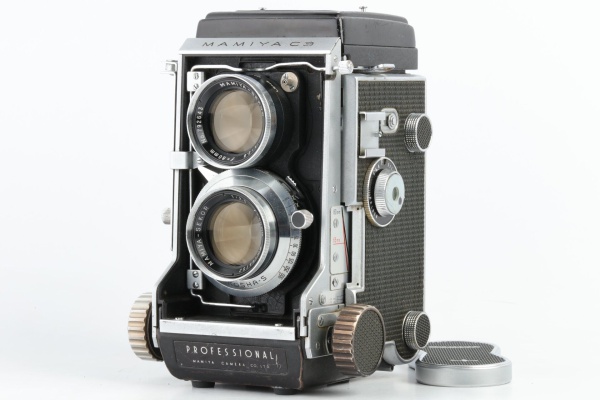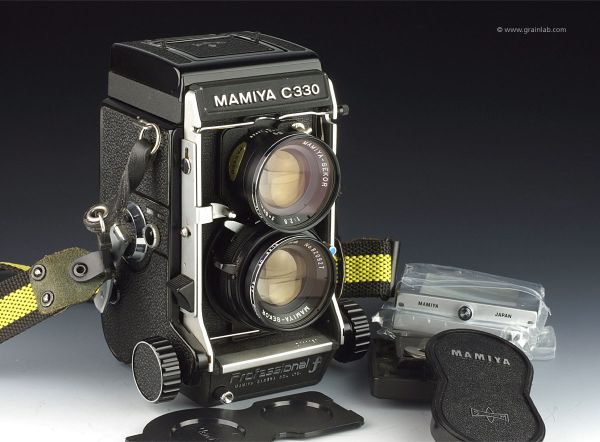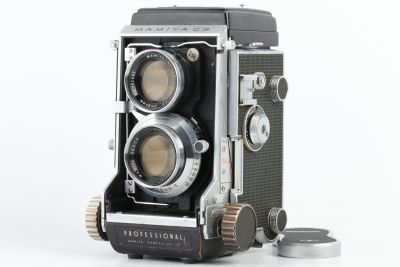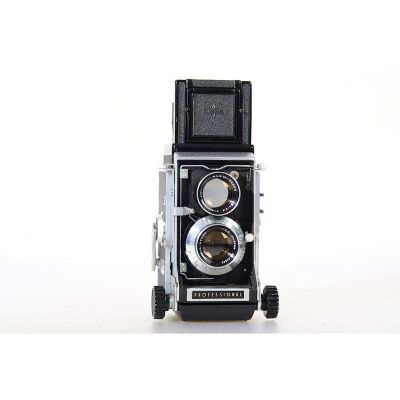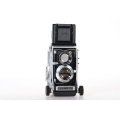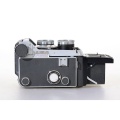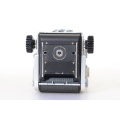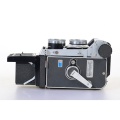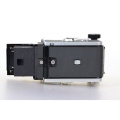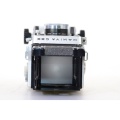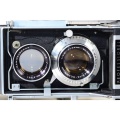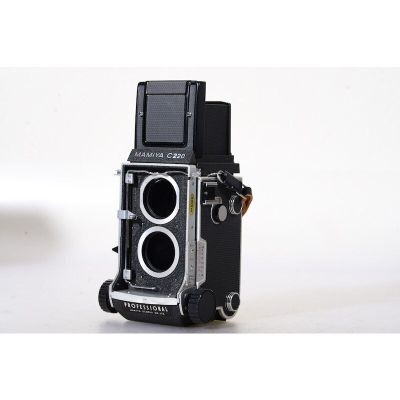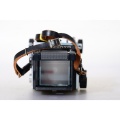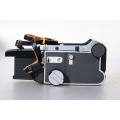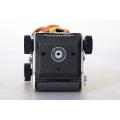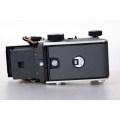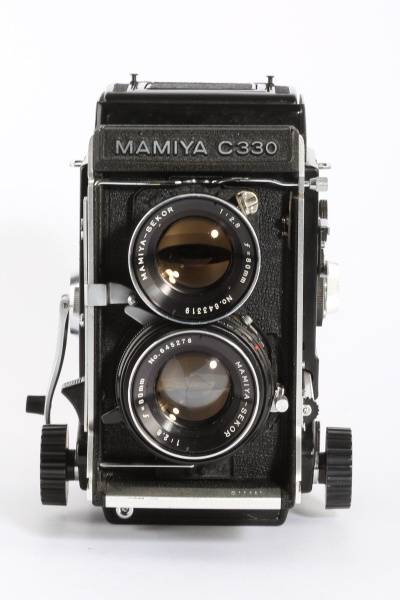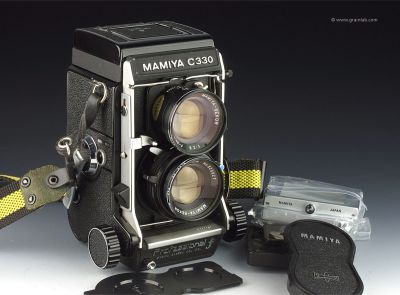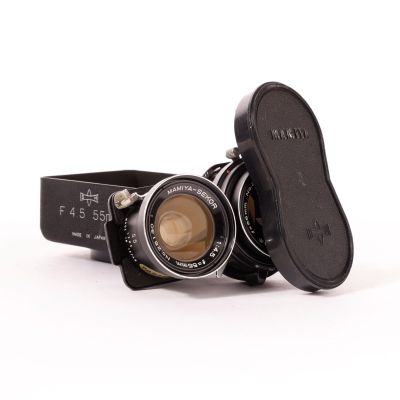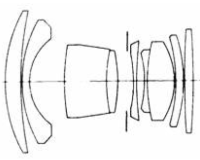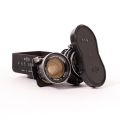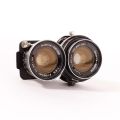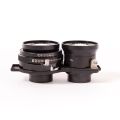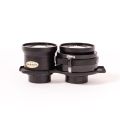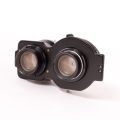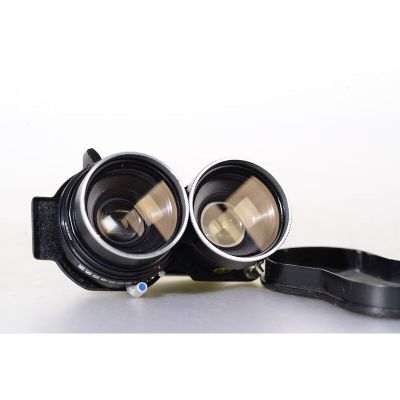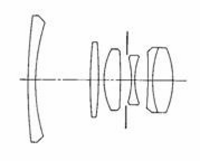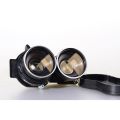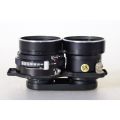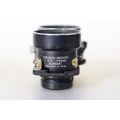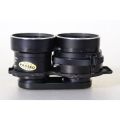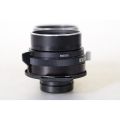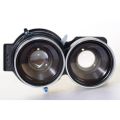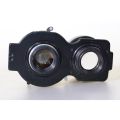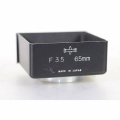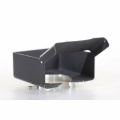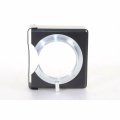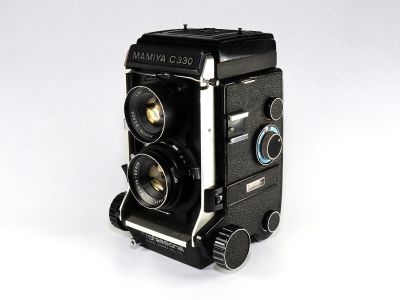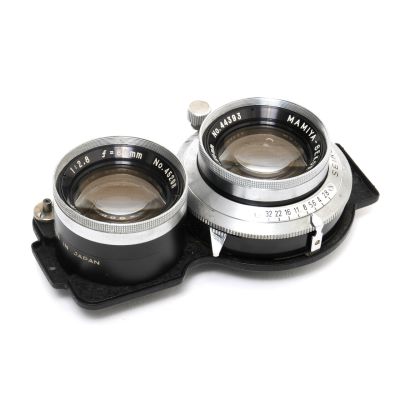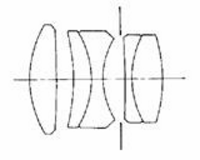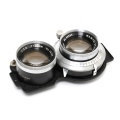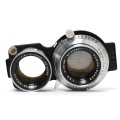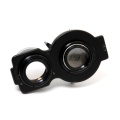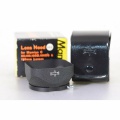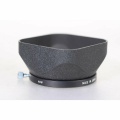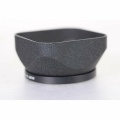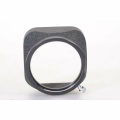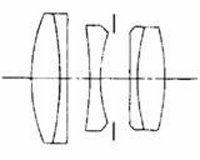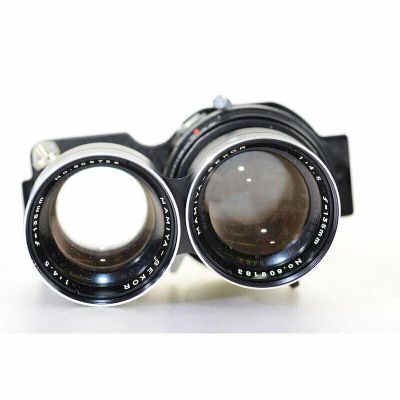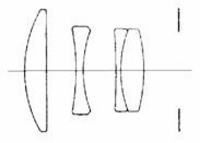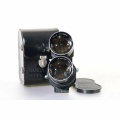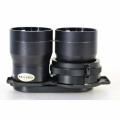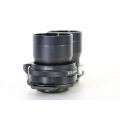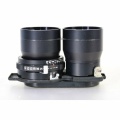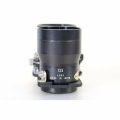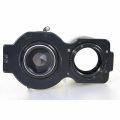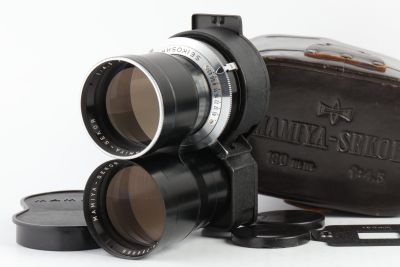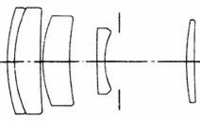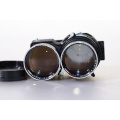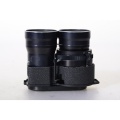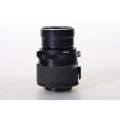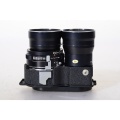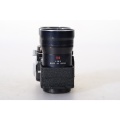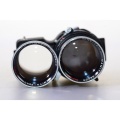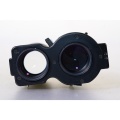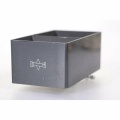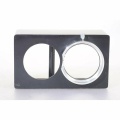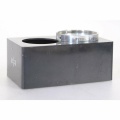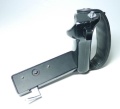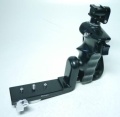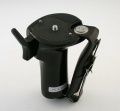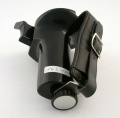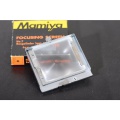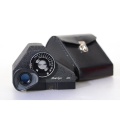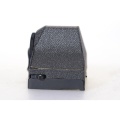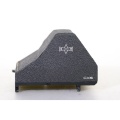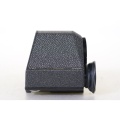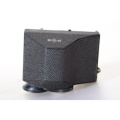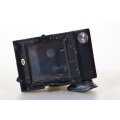Mamiya C: Unterschied zwischen den Versionen
K (Text eingefügt) |
K (Text eingefügt) |
||
| Zeile 862: | Zeile 862: | ||
== Objektive des Mamiya-C-Systems == | == Objektive des Mamiya-C-Systems == | ||
| − | === | + | === Grundsätzliches === |
| − | Viele der aufgetauchten [[Objektiv]]e wurden in | + | Viele der aufgetauchten [[Objektiv]]e wurden in unterschiedlichen Varianten geliefert: |
| − | ==== " | + | ==== "Silberfarbende" Objektive ==== |
| + | ===== Seikosha-MX-[[Verschluss]] ===== | ||
Diese [[Objektiv]] waren "silberfarbend" und mit einem Seikosha-MX-[[Verschluss]] (1, 1/2, 1/5, 1/10, 1/25, 1/50, 1/100, 1/200, und 1/400s) ausgestattet. | Diese [[Objektiv]] waren "silberfarbend" und mit einem Seikosha-MX-[[Verschluss]] (1, 1/2, 1/5, 1/10, 1/25, 1/50, 1/100, 1/200, und 1/400s) ausgestattet. | ||
| Zeile 881: | Zeile 882: | ||
:''"The first series of lenses had Seikosha-MX shutters with a speed range of 1 – 1/400th second. This was the usual 1, ½, 1/5, 1/10, 1/25, 1/50, 1/100, 1/200, 1/400 step series. In common with a number of early leaf shutter designs the fastest speed can only be set with the shutter uncocked. The lens range was 65mm, 80mm (f2.8 only), 105mm, and 135mm. The optical construction is believed to be that same as the second chrome series, but this is unverified. Spares for these lenses are not easy to obtain due to their age and small production run. The shutter release is short and curved compared to later lenses, and the shutter cocking lever is smaller than that on the Seikosha-S shutters. The shutter cocking stroke is 67 degrees 30 minutes which is much less than the 112 degree 30 minute stroke of the later bodies. The M and X synchronisation lever looks like a miniature shutter cocking lever rather than the small projection used on the later lenses . It usually has a red insert in the end of the lever. The 80mm f2.8 is marked ‘f=8cm’. At least one example has a 7 digit number on the shutter body in addition to the normal lens numbers. Some (if not all) 135mm lenses were marked as ’13.5cm’. On one example the bottom of the lens mounting flange bears the text ‘Made in Japan’ in white. Sales period December 1956 to March 1959.<br>Note: These lenses will not fit on auto-cocking bodies (C33, C330, C330f, C330s)."'' | :''"The first series of lenses had Seikosha-MX shutters with a speed range of 1 – 1/400th second. This was the usual 1, ½, 1/5, 1/10, 1/25, 1/50, 1/100, 1/200, 1/400 step series. In common with a number of early leaf shutter designs the fastest speed can only be set with the shutter uncocked. The lens range was 65mm, 80mm (f2.8 only), 105mm, and 135mm. The optical construction is believed to be that same as the second chrome series, but this is unverified. Spares for these lenses are not easy to obtain due to their age and small production run. The shutter release is short and curved compared to later lenses, and the shutter cocking lever is smaller than that on the Seikosha-S shutters. The shutter cocking stroke is 67 degrees 30 minutes which is much less than the 112 degree 30 minute stroke of the later bodies. The M and X synchronisation lever looks like a miniature shutter cocking lever rather than the small projection used on the later lenses . It usually has a red insert in the end of the lever. The 80mm f2.8 is marked ‘f=8cm’. At least one example has a 7 digit number on the shutter body in addition to the normal lens numbers. Some (if not all) 135mm lenses were marked as ’13.5cm’. On one example the bottom of the lens mounting flange bears the text ‘Made in Japan’ in white. Sales period December 1956 to March 1959.<br>Note: These lenses will not fit on auto-cocking bodies (C33, C330, C330f, C330s)."'' | ||
| − | ==== | + | ===== Seikosha-S-[[Verschluss]] ===== |
Diese [[Objektiv]]e waren (auch) "silberfarbend" und mit einem Seikosha-S-[[Verschluss]] (1-1/500s, B) ausgestattet. | Diese [[Objektiv]]e waren (auch) "silberfarbend" und mit einem Seikosha-S-[[Verschluss]] (1-1/500s, B) ausgestattet. | ||
| + | |||
| + | Folgende [[Objektiv]]e dieses Typs sind bekannt/aufgetaucht: | ||
| + | * [[#Mamiya-Sekor_1:3.2C5.2F65_mm|Mamiya-Sekor 1:3,5/65 mm]] | ||
| + | * [[#Mamiya-Sekor_1:3.2C7.2F80_mm|Mamiya-Sekor 1:3,7/80 mm]] | ||
| + | * [[#Mamiya-Sekor_1:2.2C8.2F80_mm|Mamiya-Sekor 1:2,8/80 mm]] | ||
| + | * [[#Mamiya-Sekor_1:3.2C5.2F105_mm|Mamiya-Sekor 1:3,5/105 mm]] | ||
| + | * [[#Mamiya-Sekor_1:4.2C5.2F135_mm|Mamiya-Sekor 1:4,5/135 mm]] | ||
| + | * [[#Mamiya-Sekor_1:4.2C5.2F180_mm|Mamiya-Sekor 1:4,5/180 mm]] | ||
Hinweise: | Hinweise: | ||
| Zeile 892: | Zeile 901: | ||
:''"The second chrome series is by far the more common, with a wider shutter speed range in a modern one stop sequence. It was in production for models up to and including the C33/C22. The shutter is labelled Seikosha-S, and is identified by the chrome shutter/aperture bezel. Portions of the lens barrels may be black. The shutter speed scale is on the left (when holding the camera for photography), and the aperture scale is on the right. Shutter adjustment is via a thin knurled ring, aperture by moving a small pointer. Speeds 1 - 1/500 + B. Most lenses have double exposure prevention, in that the shutter release lever will only move when the shutter is cocked. However with some the release lever will move on the un-cocked shutter, giving the impression that the shutter has fired. Parts for these lenses are also limited. Sales period uncertain – ought to have been the mid-1960’s until superseded."'' | :''"The second chrome series is by far the more common, with a wider shutter speed range in a modern one stop sequence. It was in production for models up to and including the C33/C22. The shutter is labelled Seikosha-S, and is identified by the chrome shutter/aperture bezel. Portions of the lens barrels may be black. The shutter speed scale is on the left (when holding the camera for photography), and the aperture scale is on the right. Shutter adjustment is via a thin knurled ring, aperture by moving a small pointer. Speeds 1 - 1/500 + B. Most lenses have double exposure prevention, in that the shutter release lever will only move when the shutter is cocked. However with some the release lever will move on the un-cocked shutter, giving the impression that the shutter has fired. Parts for these lenses are also limited. Sales period uncertain – ought to have been the mid-1960’s until superseded."'' | ||
| − | ==== | + | ===== Seiko-SLV-, Seiko- oder Copal-[[Verschluss]] ===== |
| − | Diese [[Objektiv]]e waren " | + | Diese [[Objektiv]]e waren "silberfarbend" und mit einem Seiko-SLV-, Seiko- oder Copal-[[Verschluss]] (1-1/500s, B) ausgestattet. |
| + | |||
| + | Folgende [[Objektiv]]e dieses Typs sind bekannt/aufgetaucht: | ||
| + | * [[#Mamiya-Sekor_1:3.2C5.2F65_mm|Mamiya-Sekor 1:3,5/65 mm]] | ||
| + | * [[#Mamiya-Sekor_1:3.2C7.2F80_mm|Mamiya-Sekor 1:3,7/80 mm]] | ||
| + | * [[#Mamiya-Sekor_1:2.2C8.2F80_mm|Mamiya-Sekor 1:2,8/80 mm]] | ||
| + | * [[#Mamiya-Sekor_1:3.2C5.2F105_mm|Mamiya-Sekor 1:3,5/105 mm]] | ||
| + | * [[#Mamiya-Sekor_1:4.2C5.2F135_mm|Mamiya-Sekor 1:4,5/135 mm]] | ||
| + | * [[#Mamiya-Sekor_1:4.2C5.2F180_mm|Mamiya-Sekor 1:4,5/180 mm]] | ||
Hinweise: | Hinweise: | ||
| + | * Vermarktungszeitraum (ca.) April 1958 bis Juli 1962 | ||
* einige [[Sucher]]-Objektive hatten eine eigene [[Blende]], die zur Kontrolle der [[Schärfentiefe]] genutzt werden kann. | * einige [[Sucher]]-Objektive hatten eine eigene [[Blende]], die zur Kontrolle der [[Schärfentiefe]] genutzt werden kann. | ||
Hierzu ein Zitat aus [http://www.gapatterson.com/grahamp/ Graham Patterson] (nicht mehr online verfügbar): | Hierzu ein Zitat aus [http://www.gapatterson.com/grahamp/ Graham Patterson] (nicht mehr online verfügbar): | ||
:''"This shutter is not thought to have been used widely. It will not auto-cock on the C33/330 bodies, but it will not foul the auto-cocking mechanism. The shutter cocking stroke is 124 degrees (the cocking arm only moves 112 degrees 30 minutes.). Sales period April 1958 to July 1962.<br>The chrome lenses are cited as late as the C330 manual, but were probably no longer in production by that time."'' | :''"This shutter is not thought to have been used widely. It will not auto-cock on the C33/330 bodies, but it will not foul the auto-cocking mechanism. The shutter cocking stroke is 124 degrees (the cocking arm only moves 112 degrees 30 minutes.). Sales period April 1958 to July 1962.<br>The chrome lenses are cited as late as the C330 manual, but were probably no longer in production by that time."'' | ||
| + | |||
| + | ==== "Schwarze" Objektive ==== | ||
| + | Diese [[Objektiv]]e waren "schwarz" und mit einem Seiko-[[Verschluss]] (1-1/500s, B) ausgestattet. Sie wurden mit den Modellen [[#Mamiya_C220|C220]] und [[#Mamiya_C330|C330]] ca. 1969 eingeführt. | ||
| + | |||
| + | Es gibt (lt. [http://www.gapatterson.com/grahamp/ Graham Patterson]) aber folgende Abweichungen: | ||
| + | * [[#Mamiya-Sekor_1:4.2C5.2F55_mm|Mamiya-Sekor 1:4,5/55 mm]] - schon im März 1967 ("schwarz") eingeführt | ||
| + | * [[#Mamiya-Sekor_1:3.2C7.2F80_mm|Mamiya-Sekor 1:3,7/80 mm]] - besitzt einen Copal-[[Verschluss]] | ||
| + | * [[#Mamiya-Sekor_1:6.2C3.2F250_mm|Mamiya-Sekor 1:6,3/250 mm]] - schon im März 1967 ("schwarz") eingeführt | ||
| + | |||
| + | Hinweise: | ||
| + | * Vermarktungszeitraum ab (ca.) 1969 | ||
| + | * einige [[Sucher]]-Objektive hatten eine eigene [[Blende]], die zur Kontrolle der [[Schärfentiefe]] genutzt werden kann. | ||
| + | * nicht alle "schwarzen" [[Objektiv]]e verfügen über eine [[Mehrschichtvergütung]] | ||
| + | * die frühesten Versionen aus dem 1960-er-Jahren sind mit der [[Brennweite]] in Zentimeter (''cm'') graviert, später erfolgte die Gravur im Millimeter (''mm'') | ||
| + | * Mitte der 1970-er-Jahre hatten die [[Objektiv]]e keine "Klickstops" bei den [[Blende]]nwerten | ||
| + | * die letzten versionen (ab ca. 1980) hatten "Klickstops" bei vollen [[Blende]]nwerten | ||
==== Optische Rechnungen ==== | ==== Optische Rechnungen ==== | ||
| Zeile 922: | Zeile 956: | ||
Ein Zitat aus einem Prospekt von [[Mamiya]]: | Ein Zitat aus einem Prospekt von [[Mamiya]]: | ||
:''"The 55 mm F4.5 lens has the widest angle of view of the Mamiya C lenses. Computed in terms of a 35 mm camera, it is equivalent to a 33 mm lens, but it actually gives a visual effect close to that of a 28 mm wideangle lens. A wider angle lens is probably impossible from the standpoint of the construction of twin-lens reflex cameras. The perspective is fully stressed, and pictures with feelings of speed can be taken. The distortion is very small, less than 1%. If the bellows is fully extended, 1: 1 magnification close-ups can be taken. It can be called a multi-purpose wideangle lens."'' | :''"The 55 mm F4.5 lens has the widest angle of view of the Mamiya C lenses. Computed in terms of a 35 mm camera, it is equivalent to a 33 mm lens, but it actually gives a visual effect close to that of a 28 mm wideangle lens. A wider angle lens is probably impossible from the standpoint of the construction of twin-lens reflex cameras. The perspective is fully stressed, and pictures with feelings of speed can be taken. The distortion is very small, less than 1%. If the bellows is fully extended, 1: 1 magnification close-ups can be taken. It can be called a multi-purpose wideangle lens."'' | ||
| + | |||
| + | Ein Zitat von [http://www.gapatterson.com/grahamp/ Graham Patterson] (nicht mehr online verfügbar) dazu: | ||
| + | :''"Retrofocus design. Cited in an American distributor's catalogue as early as 30th March 1967, but actual availability is unknown. An insert for the finder bases was produced to provide corrected parallax and exposure indices."'' | ||
==== Technische Daten ==== | ==== Technische Daten ==== | ||
| Zeile 986: | Zeile 1.023: | ||
Ein Zitat aus einem Prospekt von [[Mamiya]]: | Ein Zitat aus einem Prospekt von [[Mamiya]]: | ||
:''"Calculated in terms of a 35 mm camera, it is a 39 mm lens, and the perspective effect is not too strong. It is particularly suited for photographs of architecture and of groups of people. With these purposes in mind, distortion has been reduced to a minimum. It can be called a standard lens for snapshots, and it is a wideangle lens favored by professionals in every field."'' | :''"Calculated in terms of a 35 mm camera, it is a 39 mm lens, and the perspective effect is not too strong. It is particularly suited for photographs of architecture and of groups of people. With these purposes in mind, distortion has been reduced to a minimum. It can be called a standard lens for snapshots, and it is a wideangle lens favored by professionals in every field."'' | ||
| + | |||
| + | Ein Zitat von [http://www.gapatterson.com/grahamp/ Graham Patterson] (nicht mehr online verfügbar) dazu: | ||
| + | :''"Originally supplied with chrome reinforcing rings in the filter threads. An insert for the finder bases was produced to provide corrected parallax and exposure indices."'' | ||
| + | |||
==== Technische Daten ==== | ==== Technische Daten ==== | ||
[[Bild:Mamiya-Sekor 65C Cut.png|thumb|right|200px|Mamiya-Sekor 1:3,5/65 mm - Linsenschnitt]] | [[Bild:Mamiya-Sekor 65C Cut.png|thumb|right|200px|Mamiya-Sekor 1:3,5/65 mm - Linsenschnitt]] | ||
| Zeile 1.046: | Zeile 1.087: | ||
[[Bild:Mamiya_C330_80_F3.7_Tauber.jpg|thumb|right|400px|[https://kameramuseum.de/objekte/mamiya-c-330-professional-37-80-mm/ Mamiya-Sekor 1:3,7/80 mm] an einer [[#Mamiya_C330|Mamiya C330]] - mit freundlicher Genehmigung von [http://de.wikipedia.org/wiki/Deutsches_Kameramuseum Kurt Tauber] ]] | [[Bild:Mamiya_C330_80_F3.7_Tauber.jpg|thumb|right|400px|[https://kameramuseum.de/objekte/mamiya-c-330-professional-37-80-mm/ Mamiya-Sekor 1:3,7/80 mm] an einer [[#Mamiya_C330|Mamiya C330]] - mit freundlicher Genehmigung von [http://de.wikipedia.org/wiki/Deutsches_Kameramuseum Kurt Tauber] ]] | ||
==== Beschreibung ==== | ==== Beschreibung ==== | ||
| − | Die genauen technischen Daten (bekannt ist 4 [[Linse]]n in 3 Gruppen) lassen sich - z. Zt. - nicht komplett nachzuvollziehen. Das [[Objektiv]] soll sehr selten sein und sich konstruktiv an das Mamiya-Sekor 1:2,8/80 mm anlehnen. Hinsichtlich der Kosten wurde die [[Lichtstärke]] auf F3.7 reduziert. | + | Die genauen technischen Daten (bekannt ist 4 [[Linse]]n in 3 Gruppen) lassen sich - z. Zt. - nicht komplett nachzuvollziehen. Das [[Objektiv]] soll sehr selten sein und sich konstruktiv an das Mamiya-Sekor 1:2,8/80 mm anlehnen. Hinsichtlich der Kosten wurde die [[Lichtstärke]] auf F3.7 reduziert. |
| + | |||
| + | Hierzu ein Zitat von [http://www.gapatterson.com/grahamp/ Graham Patterson] (nicht mehr online verfügbar): | ||
:''"Rare 'Budget' lens. From notes in C330 and C330s manuals, this lens was manually cocked. The shutter and aperture index and the cocking lever are on the right, adjacent to the shutter release lever. This is completely at odds with all the other lenses in the range. The shutter release lever will move even if the lens is not cocked – which can fool the double exposure prevention mechanism. Appears to have been discontinued during the life of the C330 as it is not cited in the system chart, though several chrome lenses are included. A Copal shutter was used, and the aperture ring has no click-stops."'' | :''"Rare 'Budget' lens. From notes in C330 and C330s manuals, this lens was manually cocked. The shutter and aperture index and the cocking lever are on the right, adjacent to the shutter release lever. This is completely at odds with all the other lenses in the range. The shutter release lever will move even if the lens is not cocked – which can fool the double exposure prevention mechanism. Appears to have been discontinued during the life of the C330 as it is not cited in the system chart, though several chrome lenses are included. A Copal shutter was used, and the aperture ring has no click-stops."'' | ||
| + | |||
==== Technische Daten ==== | ==== Technische Daten ==== | ||
{| | {| | ||
| Zeile 1.105: | Zeile 1.149: | ||
Ein Zitat aus einem Prospekt von [[Mamiya]]: | Ein Zitat aus einem Prospekt von [[Mamiya]]: | ||
:''"A lens with a focal length close to the diagonal of the negative is defined as a standard lens (79.1 mm in the 6X6 format), and in this sense this 80 mm lens is the standard among standard lenses. Calculated in terms of a 35 mm camera, it is a 48 mm lens_ The lens construction is the so-called Tesser type with further improvements, so that there is uniform sharpness from corner to corner."'' | :''"A lens with a focal length close to the diagonal of the negative is defined as a standard lens (79.1 mm in the 6X6 format), and in this sense this 80 mm lens is the standard among standard lenses. Calculated in terms of a 35 mm camera, it is a 48 mm lens_ The lens construction is the so-called Tesser type with further improvements, so that there is uniform sharpness from corner to corner."'' | ||
| + | |||
| + | Ein Zitat von [http://www.gapatterson.com/grahamp/ Graham Patterson] (nicht mehr online verfügbar) dazu: | ||
| + | :''"'S' version does not have markings surrounding the lens front elements. Lens details and serial on top of viewing lens. The viewing lens is of different design from the taking lens, and elements are definitely not interchangeable with the taking lens."'' | ||
| + | |||
[[Bild:Mamiya-Sekor 80C Cut.png|thumb|right|200px|Mamiya-Sekor 1:2,8/80 mm - Linsenschnitt]] | [[Bild:Mamiya-Sekor 80C Cut.png|thumb|right|200px|Mamiya-Sekor 1:2,8/80 mm - Linsenschnitt]] | ||
| − | |||
Es sind drei Varianten des [[Objektiv]]s bekannt: | Es sind drei Varianten des [[Objektiv]]s bekannt: | ||
* "Mamiya-Sekor" - Seikosha-MX | * "Mamiya-Sekor" - Seikosha-MX | ||
| Zeile 1.175: | Zeile 1.222: | ||
Ein Zitat aus einem Prospekt von [[Mamiya]]: | Ein Zitat aus einem Prospekt von [[Mamiya]]: | ||
| − | :''"The focal length is equal to that of the 63 mm for the 35 mm camera, and it has a slightly narrow angle of view as a standard lens. With this focal length the lens eliminates deformation of the subject in portraiture and close-ups of merchandise. Yet it is not as narrow in angle of view as the | + | :''"The focal length is equal to that of the 63 mm for the 35 mm camera, and it has a slightly narrow angle of view as a standard lens. With this focal length the lens eliminates deformation of the subject in portraiture and close-ups of merchandise. Yet it is not as narrow in angle of view as the telephoto lens. It can even be said that this lens established the position of the Mamiya C cameras. Ever since the birth of the first Mamiya C camera, it has been welcomed by cameramen as a lens with a very convenient focal length."'' |
| − | telephoto lens. It can even be said that this lens established the position of the Mamiya C cameras. Ever since the birth of the first Mamiya C camera, it has been welcomed by cameramen as a lens with a very convenient focal length."'' | + | |
| + | Ein Zitat von [http://www.gapatterson.com/grahamp/ Graham Patterson] (nicht mehr online verfügbar) dazu: | ||
| + | :''"The 105mm D appears to be an optical re-design from the earlier 105mm black, with a consequent change in back-focus. At the moment the best evidence suggests that only the last DS variant had a viewing lens diaphragm and depth of field calculator ring. Most users agree that the DOF preview is of limited utility, but the DOF calculator is useful if treated conservatively. Long focus. Focus scales may not match on pre C330s cameras. The D or DS engraving is in red."'' | ||
Es sind folgende Varianten bekannt/aufgetaucht: | Es sind folgende Varianten bekannt/aufgetaucht: | ||
| Zeile 1.237: | Zeile 1.286: | ||
Ein Zitat aus einem Prospekt von [[Mamiya]]: | Ein Zitat aus einem Prospekt von [[Mamiya]]: | ||
:''"This is equivalent to the 81 mm lens for the 35 mm camera, and it was developed for use in taking studio portraits. Delineation ability is excellent. It. is very compact for a 135 mm telephoto lens, and it is only 10 grams heavier than the 105 mm standard lens. Since the focal length is close to that of the unique 105 mm standard lens, there are not too many users of this 135 mm lens, but it is a lens convenient for telescopic close-up shots."'' | :''"This is equivalent to the 81 mm lens for the 35 mm camera, and it was developed for use in taking studio portraits. Delineation ability is excellent. It. is very compact for a 135 mm telephoto lens, and it is only 10 grams heavier than the 105 mm standard lens. Since the focal length is close to that of the unique 105 mm standard lens, there are not too many users of this 135 mm lens, but it is a lens convenient for telescopic close-up shots."'' | ||
| + | |||
| + | Ein Zitat von [http://www.gapatterson.com/grahamp/ Graham Patterson] (nicht mehr online verfügbar) dazu: | ||
| + | :''"The lens diaphragm and shutter is located behind the lens elements, and is exposed when the rear cap is removed. Long focus design."'' | ||
Es sind folgende Varianten bekannt/aufgetaucht: | Es sind folgende Varianten bekannt/aufgetaucht: | ||
| Zeile 1.303: | Zeile 1.355: | ||
Ein Zitat aus einem Prospekt von [[Mamiya]]: | Ein Zitat aus einem Prospekt von [[Mamiya]]: | ||
:''"Equivalent to the 108 mm lens for the 35 mm camera, it is the most popular telephoto lens in the Mamiya C interchangeable lens family. There is no subject which cannot be photographed with this lens, including portraits, scenery and snapshots. It has the longest focal length of the lens which can be used with the Mamiya C330 for self-cocking. The various abberations have been corrected, so that high-quality del ineation is possible even at full aperture.<br>The conventional 180mm lens for the Model C cannot be mounted on this camera; use the 180mm lens for Model C33."'' | :''"Equivalent to the 108 mm lens for the 35 mm camera, it is the most popular telephoto lens in the Mamiya C interchangeable lens family. There is no subject which cannot be photographed with this lens, including portraits, scenery and snapshots. It has the longest focal length of the lens which can be used with the Mamiya C330 for self-cocking. The various abberations have been corrected, so that high-quality del ineation is possible even at full aperture.<br>The conventional 180mm lens for the Model C cannot be mounted on this camera; use the 180mm lens for Model C33."'' | ||
| + | |||
| + | Ein Zitat von [http://www.gapatterson.com/grahamp/ Graham Patterson] (nicht mehr online verfügbar) dazu: | ||
| + | :''"Optical redesign from the earlier version. The filter ring is very thin and exposed, and is easily dented. Some lenses come with alloy rings which stiffen the threads when filters are not attached. Telephoto design, which is more complex than the earlier model. The word 'Super' is engraved on the bezel around the front element in red, and the ‘180’ engraving on top of the viewing lens is also red. One example has been reported that does not have the ‘180’ engraving and the shutter is marked ‘Seiko – SLV’."'' | ||
Es sind folgende Varianten bekannt/aufgetaucht: | Es sind folgende Varianten bekannt/aufgetaucht: | ||
| Zeile 1.377: | Zeile 1.432: | ||
Ein Zitat aus einem Prospekt von [[Mamiya]]: | Ein Zitat aus einem Prospekt von [[Mamiya]]: | ||
:''"This is the telephoto lens with the longest focal length in the Mamiya-Sekor interchangeable lens family . It is equivalent to the 150 mm lens for the 35 mm camera. The far-near feeling is drastically compressed, and powerful pictures can be taken bringing faraway objects up very close. The design features high telephoto ratio, while it is compact and lightweight so that hand-held photography is easy."'' | :''"This is the telephoto lens with the longest focal length in the Mamiya-Sekor interchangeable lens family . It is equivalent to the 150 mm lens for the 35 mm camera. The far-near feeling is drastically compressed, and powerful pictures can be taken bringing faraway objects up very close. The design features high telephoto ratio, while it is compact and lightweight so that hand-held photography is easy."'' | ||
| + | |||
| + | Ein Zitat von [http://www.gapatterson.com/grahamp/ Graham Patterson] (nicht mehr online verfügbar) dazu: | ||
| + | :''"Manual cocking on all bodies. Telephoto design. Cited in an American distributor's catalogue as early as 30th March 1967, but actual availability is unknown."'' | ||
| + | |||
==== Technische Daten ==== | ==== Technische Daten ==== | ||
[[Bild:Mamiya-Sekor 250C Cut.png|thumb|right|200px| Mamiya-Sekor 1:6,3/250 mm - Linsenschnitt]] | [[Bild:Mamiya-Sekor 250C Cut.png|thumb|right|200px| Mamiya-Sekor 1:6,3/250 mm - Linsenschnitt]] | ||
Version vom 24. Mai 2023, 13:40 Uhr
Einführung
Viele asiatische Kamerahersteller orientierten sich in den 1950er-Jahren an den Produkten der (damals führenden) deutschen Hersteller - diese waren in der Regel die "Schraubgewinde-Leica", die Messucher-Contax sowie die zweiäugige Rolleiflex.
So auch bei Mamiya - eine "Kopie" der zweiäugigen Rolleiflex wurde in den frühen 1950er-Jahren worgestellt: Die Mamiyaflex.
Wie auch bei der Rolleiflex handelt es sich um eine klassische zweiäugige Spiegelreflexkamera (Sucher und das bildgebende Objektiv besitzen getrennte (übereinander liegende) Linsensätze ohne Wechselmöglichkeit) sowie einen Zentralverschluss im bildgebenden Objektiv.
Lt. den bekannten Quellen existierten bei Rollei einige Prototypen, bei denen es möglich war, die Objektivgruppe zu wechseln - diese gelangten aber nicht über einen Prototypen-Status hinaus. Nach Veröffentlichungen ehemaliger Mitarbeiter soll dies der damalige Miteigentümer (Reinhold Heidecke) abgelehnt haben, Rollei vermarktete dagegen zwei unterschiedliche zweiäugige Spiegelreflexkameras: Die Tele- (135mm-Objektiv) und die Weitwinkel-Rolleiflex (55mm-Objektiv).
Zeitgleich entwickelten die Ingenieure von Mamiya das Prinzip der Rolleiflex (mit den fest eingebauten Objektiven) weiter und veröffentlichten im Jahr 1956 die (wahrscheinlich) erste zweiäugige Spiegelreflexkamera mit wechselbaren Objektiven: Die Mamiyaflex C.
Zur Kamera wurde umfangreiches Zubehör angeboten (z.B. Einstellscheiben, Sucher).
Zeitreihe der Mamiya-C-Modelle (mit OEM-Produkten)
| Bezeichnung | Produktion (von-bis) | Anmerkungen |
| Mamiyaflex C | 1956-1958 | |
| Mamiyaflex C2 | 1958-1962 | |
| Mamiya C3 | 1962-1965 | |
| Mamiya C33 | 1965-1969 | Wurde auch als Revue C33 Professional vermarktet. |
| Mamiya C22 | 1966-1968 | |
| Mamiya C220 | 1968-? | |
| Mamiya C330 | 1969-1974 | |
| Mamiya C330f | 1972-1982 | |
| Mamiya C220f | 1982-1995 | |
| Mamiya C330s | 1983-1994 |
Kameras des Mamiya-C-Systems
Gemeinsame Merkmale aller Kameras des Mamiya-C-Systems
Hier - in Kurzform - die gemeinsamen Merkmale aller Kameras des Mamiya-C-Systems:
- Typ zweiäugige Spiegelreflexkamera
- wechselbare (miteinander "verblockte") Objektivsätze mit je einem
- (teilweise einfacher aufgebauten) Sucher-Objektiv (einige dieser Objektive hatten zusätzlich eine Blende zur Simulation der Schärfentiefe)
- Aufnahme-Objektiv mit eingebautem Zentralverschluss
- das Sucher-Objektiv "spiegelt" mit einem festen 45-Grad-Spiegel auf die (teilweise wechselbare) Mattscheibe
- das Sucherfeld (51 x 51 mm) ist kleiner als das Aufnahmeformat (56 x 56 mm)
- Lichtschachtsucher (teilweise wechselbar)
- (teilweise) abschaltbare Doppelbelichtungssperre
- Fokussierung über einen (sehr langen) Balgen mittels Einstellrad
- Wechselsucher (teilweise)
- Wechselrückwände (teilweise)
Die Unterschiede zwischen den einzelnen Modellen werden in den nachfolgenden Abschnitten detailliert aufgeführt.
Mamiyaflex C
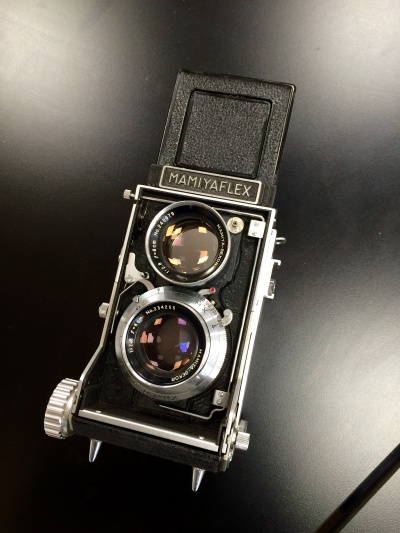
Beschreibung
Hierbei handelt es sich um das Grundmodell des Mamiya-C-Systems, gut erkennbar an dem einseitigen (rechtsliegenden) Drehrad zur Fokussierung, es soll aber Exemplare geben, bei denen das Drehrad auf der linken Seite sein soll.
Hierzu ein Zitat aus "Mamiya TLRs" in tlr-cameras.com:
- "The original C Professional was launched in 1956/7, and is very rare, with production rapidly swithched to the improved C2. It is distinguished by having only one focus knob (usually on the right, although I believe some left-handed ones were made."
Technische Daten
| Produktionszeitraum: | Oktober 1956/Januar 1957 bis ca. 1958 |
| Gewicht: | unbekannt |
| Filmtransport: | manuell, Bildzählwerk (automatisch) |
| Verschlussaufzug: | manuell |
| Auslöser: | rechte Seite |
| Parallaxenausgleich: | Skala |
| Belichtungskorrektur: | Skala |
| Filmtypen: | nur 120 |
| Fokusskalen: | 80 mm, 105 mm, 135 mm |
| Mattscheibe: | nicht wechselbar |
| Sucher: | Lichtschachtsucher (fest eingebaut) |
| Blitzanschluss: | vorhanden, kein Kontakt vorgesehen |
| Rückteil: | abnehmbar |
| Mehrfachbelichtung: | manuelle Verriegelung zur Vermeidung von Doppelbelichtungen |
| Kabelauslöser: | strittig, einige bekannte Exemplare sind mit, weitere Exemplare sind ohne Anschluss aufgetaucht |
| Stativgewinde: | 1/4 Zoll (ISO 1222) im Kameraboden |
| Sonstiges: | Zeitgleich mit der Kamera wurden die silberfarbenden Objektive mit den Brennweiten 80 mm, 105 mm und 135 mm vorgestellt (Kürzeste Zeit jeweils 1/400s). Das Bildzählwerk muss manuell zurückgesetzt werden. Rechts findet sich der Fokusknopf, links gegenüber die Fokussperre. |
| Kaufpreis: | |
| Kadlubek-Code: | MAM0820 |
Quelle: Graham Patterson (nicht mehr online verfügbar)
Galerie
Hier eine kleine Galerie mit Bildern der Kamera:
Mamiyaflex C - photo courtesy of commons.wikimedia.org (sébastien amiet)
Mamiyaflex C2
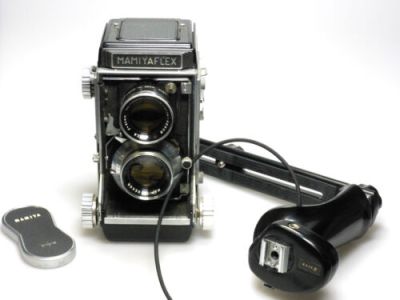
Beschreibung
Weiterentwicklung der Mamiyaflex C aus dem Jahr 1958.
Zusätzlich zur Mamiyaflex C verfügt die "C2" doppelte Einstellräder zur Fokussierung (links/rechts) und besitzt einen eingebauten Sportsucher im Lichtschachtsucher.
Hierzu ein Zitat aus "Mamiya TLRs" in tlr-cameras.com:
- "The C2 was launched in 1958, improved mainly by two focus knobs rather than one, by a removable hood and the Seikosha-S shutter on the standard lens. Rack extension/ bellows focus down to 7" transformed the TLR market. SHutters were also improved."
Technische Daten
| Produktionszeitraum: | Juni 1958 bis ca. 1962 |
| Gewicht: | 1.250 Gramm |
| Filmtransport: | manuell, Bildzählwerk (automatisch), bei eingelegtem Film erscheint in einem Fenster ein roter Punkt |
| Verschlussaufzug: | manuell |
| Auslöser: | rechte Seite |
| Parallaxenausgleich: | zwei Linien |
| Belichtungskorrektur: | Skala |
| Filmtypen: | nur 120 |
| Fokusskalen: | 80 mm, 105 mm, 135 mm, es sind Exemplare mit weiteren Brennweiten bekannt |
| Mattscheibe: | nicht wechselbar |
| Sucher: | Lichtschachtsucher (fest eingebaut) |
| Blitzanschluss: | vorhanden, kein Kontakt vorgesehen |
| Rückteil: | abnehmbar, spezielle Rückwand für Planfilme möglich |
| Mehrfachbelichtung: | es gibt nur eine Filmtransportsperre aber keine Verschlusssperre |
| Kabelauslöser: | vorhanden |
| Stativgewinde: | 1/4 Zoll (ISO 1222) im Kameraboden |
| Sonstiges: | Zwei Knöpfe zur Fokussierung vorhanden (Fokussperre entfällt) Zeitgleich mit der Kamera wurden zusätzliche Objektive mit den Brennweiten 65 mm und 180 mm vorgestellt. |
| Kaufpreis: | |
| Kadlubek-Code: | MAM0830 |
Quelle: Graham Patterson (nicht mehr online verfügbar)
Galerie
Hier eine kleine Galerie mit Bildern der Kamera:
Mamiyaflex C2 - Scan aus der Bedienungsanleitung der Kamera
Mamiyaflex C2 - mit freundlicher Genehmigung von camerafoxx
Mamiyaflex C2 - mit freundlicher Genehmigung von camerafoxx
Mamiyaflex C2 - mit freundlicher Genehmigung von camerafoxx
Mamiyaflex C2 - mit freundlicher Genehmigung von camerafoxx
Mamiyaflex C2 - mit freundlicher Genehmigung von camerafoxx
Mamiya C3
Beschreibung
Weiterentwicklung der Mamiyaflex C2 aus dem Jahr 1962.
Im Gegensatz zur Mamiyaflex C2 erfolgt der gleichzeitige Verschlussaufzug und Filmtransport mit einer Transportkurbel.
Hierzu ein Zitat aus "Mamiya TLRs" in tlr-cameras.com:
- "The C3XX series differs from the C2xx chiefly by having a film-advance crank, rather than a knob. Auto exposure prevention. This is the first of the long-lived series, made c 1962."
Technische Daten
| Produktionszeitraum: | September 1962 bis ca. 1965 |
| Gewicht: | ? Gramm |
| Filmtransport: | mit Kurbel, Bildzählwerk (automatisch) |
| Verschlussaufzug: | manuell |
| Auslöser: | rechte Seite |
| Parallaxenausgleich: | Skala |
| Belichtungskorrektur: | Skala |
| Filmtypen: | nur 120 |
| Fokusskalen: | 65 mm, 80 mm, 105 mm, 135 mm, 180 mm, es sind Exemplare mit weiteren Brennweiten bekannt Nachrüstung der 55-mm- und 250-mm-Objektive waren verfügbar |
| Mattscheibe: | nicht wechselbar |
| Sucher: | Lichtschachtsucher (fest eingebaut) |
| Blitzanschluss: | vorhanden, kein Kontakt vorgesehen |
| Rückteil: | abnehmbar, spezielle Rückwand für Planfilme möglich |
| Mehrfachbelichtung: | ja |
| Kabelauslöser: | vorhanden |
| Stativgewinde: | 1/4 Zoll (ISO 1222) im Kameraboden |
| Sonstiges: | Die verfügbaren Objektive hatten 1/500s als kürzeste Verschlusszeit. Bildzählwerk mit automatischer Nullstellung. |
| Kaufpreis: | |
| Kadlubek-Code: | MAM0840 |
Quelle: Graham Patterson (nicht mehr online verfügbar)
Galerie
Hier eine kleine Galerie mit Bildern der Kamera:
Mamiya C33

Beschreibung
Weiterentwicklung der Mamiya C3 aus dem Jahr 1965.
Im Vergleich zur Mamiya C3 können jetzt auch 120er- und 220er-Filme (umschaltbar) verwendet werden, weiterhin gibt es einen automatischen Parallaxe-Ausgleich im Sucher.
Die Mamiya C33 wurde - technisch unverändert - auch als Revue C33 Professional vermarktet - s. hierzu die Bildbeispiele in der Galerie.
Hierzu ein Zitat aus "Mamiya TLRs" in tlr-cameras.com:
- "The C33 series succeeded the C3 c 1965. Film-advance crank now tensioned the shutter. Automatic parallax compensation."
Technische Daten
| Produktionszeitraum: | April 1965 bis ca. 1969 |
| Gewicht: | 1.810 Gramm |
| Filmtransport: | mit Kurbel, Bildzählwerk (automatisch) |
| Verschlussaufzug: | automatisch durch die Filmtransportkurbel |
| Auslöser: | rechte Seite |
| Parallaxenausgleich: | automatisch fpr die Brennweiten 80 mm, 105 mm, 135 mm und 180 mm |
| Belichtungskorrektur: | Skala |
| Filmtypen: | nur 120, Modifikationen für 220 sind bekannt |
| Fokusskalen: | 65 mm, 80 mm, 105 mm, 135 mm, 180 mm, es sind Exemplare mit weiteren Brennweiten bekannt Modelle ab 1968 hatten Skalen für die 55-mm- und 250-mm-Objektive |
| Mattscheibe: | nicht wechselbar |
| Sucher: | Lichtschachtsucher (fest eingebaut) |
| Blitzanschluss: | vorhanden, kein Kontakt vorgesehen |
| Rückteil: | abnehmbar, spezielle Rückwand für Planfilme möglich |
| Mehrfachbelichtung: | ja |
| Kabelauslöser: | vorhanden |
| Stativgewinde: | 1/4 Zoll (ISO 1222) im Kameraboden |
| Sonstiges: | Die Filmtransportkurbel sollten nach jedem Aufzug in die Ruheposition gedreht werden. |
| Kaufpreis: | |
| Kadlubek-Code: | MAM0860 |
Quelle: Graham Patterson (nicht mehr online verfügbar)
Galerie
Hier eine kleine Galerie mit Bildern der Kamera:
Revue C33 Professional - mit freundlicher Genehmigung von Foto Brell, Frankfurt
Revue C33 Professional - mit freundlicher Genehmigung von Foto Brell, Frankfurt
Revue C33 Professional - mit freundlicher Genehmigung von Foto Brell, Frankfurt
Revue C33 Professional - mit freundlicher Genehmigung von Foto Brell, Frankfurt
Revue C33 Professional - mit freundlicher Genehmigung von Foto Brell, Frankfurt
Revue C33 Professional - mit freundlicher Genehmigung von Foto Brell, Frankfurt
Revue C33 Professional - mit freundlicher Genehmigung von Foto Brell, Frankfurt
Revue C33 Professional - mit freundlicher Genehmigung von Foto Brell, Frankfurt
Revue C33 Professional - mit freundlicher Genehmigung von Foto Brell, Frankfurt
Revue C33 Professional - mit freundlicher Genehmigung von Foto Brell, Frankfurt
Revue C33 Professional - mit freundlicher Genehmigung von Foto Brell, Frankfurt
Revue C33 Professional - mit freundlicher Genehmigung von Foto Brell, Frankfurt
Mamiya C22
Beschreibung
Um den Verkaufspreis senken zu können, wurde 1966 ein vereinfachtes Modell vorgestellt: Die Mamiya C22.
Es handelt sich um eine abgespeckte Version der Mamiya C33 (getrennter Verschlussaufzug und Filmtransport, nur Parallaxe-Marken im Sucher).
Hierzu ein Zitat aus "Mamiya TLRs" in tlr-cameras.com:
- "The first of this series was the C2, succeeding the Mamiyaflex C. The C22 (1966) is a lighter body with knob advance. 120/220 backs available."
Technische Daten
| Produktionszeitraum: | März 1966 bis 1968 |
| Gewicht: | 1.480 Gramm |
| Filmtransport: | Transportknopf, optional Transportkurbel |
| Verschlussaufzug: | manuell |
| Auslöser: | rechte Seite |
| Parallaxenausgleich: | |
| Belichtungskorrektur: | |
| Filmtypen: | 120 und 220 (drehbare Andruckplatte) |
| Fokusskalen: | 65 mm, 80 mm 55 mm, 250 mm nachrüstbar |
| Mattscheibe: | nicht wechselbar |
| Sucher: | Lichtschachtsucher (fest eingebaut) |
| Blitzanschluss: | vorhanden, kein Kontakt vorgesehen |
| Rückteil: | abnehmbar, Planfilmrückteil verwendbar |
| Mehrfachbelichtung: | ja |
| Kabelauslöser: | vorhanden |
| Stativgewinde: | 1/4 Zoll (ISO 1222) im Kameraboden |
| Sonstiges: | Das Bildzählwerk stellt sich automatisch zurück. Wurde sehr wahrscheinlich auch mit dem Mamiya-Sekor 1:3.7/80 mm verkauft. Beim Wechsel von 120er- auf den 220er-Film muss die Filmandruckplatte gedreht werden, weiterhin muss das Bildzählwerk manuell eingestellt werden. |
| Kaufpreis: | |
| Kadlubek-Code: | MAM0850 |
Quelle: Graham Patterson (nicht mehr online verfügbar)
Galerie
Mamiyaflex C22 - Scan aus der Bedienungsanleitung der Kamera
Mamiya C220
Beschreibung
Wie schon bei der Mamiya C22 stellte Mamiya im Jahr 1968 eine vereinfachte Variante der Mamiya C330 vor: Die Mamiya C220.
Beim Modell "C220" handelt es sich um eine "abgespeckte Variante" der Mamiya C330 - folgende Unterschiede sind bekannt:
- keine automatische Sichtfeldkorrektur, es sind lediglich Referenzlinien für die verschiedenen Entfernungen auf der Suchermattscheibe angebracht
- der Verschluss muss separat mauell - wie bei der Rolleicord - gespannt werden
- die "C220" ist leichter (1.150 Gramm gegenüber 1.465 Gramm der Mamiya C330)
Hierzu ein Zitat aus "Mamiya TLRs" in tlr-cameras.com:
- "Followed the C22 (1968). Small crank on wind knob. Single back takes 120/220 film. Later (1982) succeeded by a C220f with minor improvements."
Technische Daten
| Produktionszeitraum: | April 1968 bis unbekannt |
| Gewicht: | 1.150 Gramm |
| Filmtransport: | mit Kurbel (ausklappbar) |
| Verschlussaufzug: | manuell |
| Auslöser: | rechte Seite |
| Parallaxenausgleich: | über Fokusskala |
| Belichtungskorrektur: | zwei Referenzlinien auf der Mattscheibe |
| Filmtypen: | 120 und 220 (drehbare Andruckplatte) |
| Fokusskalen: | 55 mm, 65 mm, 80 mm, 105 mm, 135 mm, 180 mm, 250 mm |
| Mattscheibe: | nicht wechselbar |
| Sucher: | Lichtschachtsucher (fest eingebaut) |
| Blitzanschluss: | vorhanden, kein Kontakt vorgesehen |
| Rückteil: | fest |
| Mehrfachbelichtung: | ja |
| Kabelauslöser: | vorhanden |
| Stativgewinde: | 1/4 Zoll (ISO 1222) im Kameraboden |
| Sonstiges: | Das Bildzählwerk stellt sich automatisch zurück. Wurde sehr wahrscheinlich auch mit dem Mamiya-Sekor 1:3.7/80 mm verkauft. Beim Wechsel von 120er- auf den 220er-Film muss die Filmandruckplatte gedreht werden, weiterhin muss das Bildzählwerk manuell eingestellt werden. |
| Kaufpreis: | |
| Kadlubek-Code: | MAM0870 |
Quelle: Graham Patterson (nicht mehr online verfügbar)
Galerie
Hier eine kleine Galerie mit Bildern der Kamera:
Mamiya C330
Beschreibung
"Brot- und Butterkamera" sehr vieler Fotografen in den späten 1960-Jahren - die Mamiya C330. Wird auch heute (Anfang 2023) sehr gerne für die analoge Fotografie genutzt. Es handelt es sich um eine sehr robuste Kamera, die (noch) relativ preiswert gebraucht zu erstehen ist.
Grundsätzlich handelt sich um eine Weiterentwicklung der Mamiya C33, hier konnten jetzt auch die Einstellscheiben gewechselt werden.
Technische Daten
| Produktionszeitraum: | Oktober 1969 bis 1974 |
| Gewicht: | 1.465 Gramm |
| Filmtransport: | mit Kurbel (ausklappbar) |
| Verschlussaufzug: | automatisch mit dem Filmtransport |
| Auslöser: | zweifach (links und rechts) |
| Parallaxenausgleich: | automatisch |
| Belichtungskorrektur: | |
| Filmtypen: | 120 und 220 (drehbare Andruckplatte), automatische Umstellung des Bildzählwerkes |
| Fokusskalen: | manuell einstellbare Brennweite, nicht geeignet für die 105-mm-D-Objektive |
| Mattscheibe: | wechselbar (Matt, 4-Grad-Teilung, 6-Grad-Teilung, Mikroprisma, Fadenkreuz, Gitter) |
| Sucher: | Lichtschachtsucher (fest eingebaut) |
| Blitzanschluss: | vorhanden, kein Kontakt vorgesehen |
| Rückteil: | wechselbar, Planfilmrücktal verwendbar |
| Mehrfachbelichtung: | ja |
| Kabelauslöser: | vorhanden |
| Stativgewinde: | 1/4 Zoll (ISO 1222) im Kameraboden |
| Sonstiges: | Keine Fokussperre vorhanden. Merkrad für Kunstlicht-/Tageslicht-/SW-Film einstellbar. |
| Kaufpreis: | |
| Kadlubek-Code: | MAM0890 |
Quelle: Graham Patterson (nicht mehr online verfügbar)
Galerie
Hier eine kleine Galerie mit Bildern der Kamera:
Mamiya C330f
Beschreibung
Weiterentwicklung der Mamiya C330 aus dem Jahr 1972, es wurden nur geringe Veränderungen vorgenommen.
Im Gegensatz zur Mamiya C330 besitzt die Mamiya C330f keine Auslösearretierung, keine ISO-Einstellung und keine Blendenvorschau.
Technische Daten
| Produktionszeitraum: | 1972 bis 1982 |
| Gewicht: | 1.390 Gramm |
| Filmtransport: | mit Kurbel (ausklappbar) |
| Verschlussaufzug: | automatisch mit dem Filmtransport |
| Auslöser: | zweifach (links und rechts) |
| Parallaxenausgleich: | automatisch |
| Belichtungskorrektur: | |
| Filmtypen: | 120 und 220 (drehbare Andruckplatte), automatische Umstellung des Bildzählwerkes |
| Fokusskalen: | manuell einstellbare Brennweite, nicht geeignet für die 105-mm-D-Objektive |
| Mattscheibe: | wechselbar (Matt, 4-Grad-Teilung, 6-Grad-Teilung, Mikroprisma, Fadenkreuz, Gitter) |
| Sucher: | Lichtschachtsucher (fest eingebaut) |
| Blitzanschluss: | vorhanden, kein Kontakt vorgesehen |
| Rückteil: | wechselbar, Planfilmrücktal verwendbar |
| Mehrfachbelichtung: | ja |
| Kabelauslöser: | vorhanden |
| Stativgewinde: | 3/8 Zoll (ISO 1222) im Kameraboden |
| Sonstiges: | |
| Kaufpreis: | |
| Kadlubek-Code: | MAM0900 |
Quelle: Graham Patterson (nicht mehr online verfügbar)
Galerie
Mamiya C220f
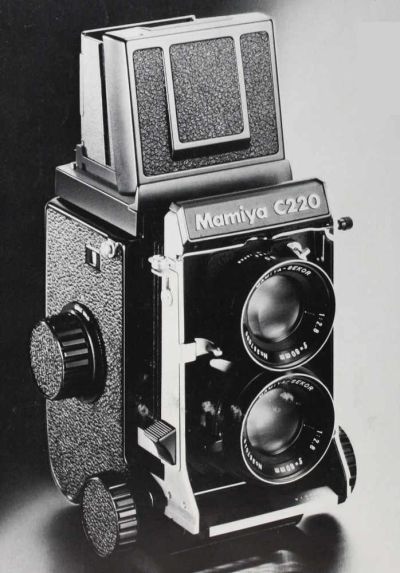
Beschreibung
Beim Modell "C220f" handelt es sich um eine "abgespeckte Variante" der Mamiya C330f aus dem Jahr 1982 - folgende Unterschiede sind bekannt:
- keine automatische Sichtfeldkorrektur, es sind lediglich Referenzlinien für die verschiedenen Entfernungen auf der Suchermattscheibe angebracht
- der Verschluss muss separat mauell - wie bei der Rolleicord - gespannt werden
Technische Daten
| Produktionszeitraum: | März 1982 bis 1995 |
| Gewicht: | 1.150 Gramm |
| Filmtransport: | Transportknopf |
| Verschlussaufzug: | manuell |
| Auslöser: | rechte Seite |
| Parallaxenausgleich: | Bildschirmmarken |
| Belichtungskorrektur: | Skala |
| Filmtypen: | 120 und 220 (drehbare Andruckplatte), automatisch umstellendes Bildzählwerk |
| Fokusskalen: | 55 mm, 65 mm, 80 mm, 105 mm, 135 mm, 180 mm, 250 mm |
| Mattscheibe: | nicht wechselbar |
| Sucher: | Lichtschachtsucher (fest eingebaut) |
| Blitzanschluss: | vorhanden, kein Kontakt vorgesehen |
| Rückteil: | fest |
| Mehrfachbelichtung: | ja |
| Kabelauslöser: | vorhanden |
| Stativgewinde: | 1/4 Zoll (ISO 1222) im Kameraboden |
| Sonstiges: | |
| Kaufpreis: | |
| Kadlubek-Code: | MAM0880 |
Quelle: Graham Patterson (nicht mehr online verfügbar)
Galerie
Mamiya C220f - Scan aus der Bedienungsanleitung der Kamera
Mamiya C330s
Beschreibung
Letztes Modell aus der Serie, 1983 vorgestellt.
Zweiäugige 6x6 Spiegelreflexkamera mit Wechselobjektiven, eingebauter Balgen für Nahaufnahmen, Filmtransport und Verschlussspannung gekoppelt. Automatische Parallaxenausgleich- und Verlängerungsfaktoren-Anzeige im Sucher, 7 auswechselbare Einstellscheiben, zwei Gehäuseauslöser.
Die Unterschiede zwischen der Mamiya C330f und "C330s" sind nur minimal, im Wesentlichen hat die "C330s" stabilere Außenschalen. Bedientechnisch bestehen keine Unterschiede zwischen den beiden Modellen.
Hierzu ein Zitat aus "Mamiya TLRs" in tlr-cameras.com:
- "Last of the line (1983) after intermediate C330f. Lighter body, parallax indicator in viewfinder. Still widely used, top-quality camera."
Technische Daten
| Produktionszeitraum: | Oktober 1983 bis Januar 1994 |
| Gewicht: | 1.340 Gramm |
| Filmtransport: | mit Kurbel (ausklappbar) |
| Verschlussaufzug: | automatisch mit dem Filmtransport |
| Auslöser: | zweifach (links und rechts) |
| Parallaxenausgleich: | automatisch |
| Belichtungskorrektur: | |
| Filmtypen: | 120 und 220 (drehbare Andruckplatte), automatische Umstellung des Bildzählwerkes |
| Fokusskalen: | manuell einstellbare Brennweite, nicht geeignet für die 105-mm-D-Objektive |
| Mattscheibe: | wechselbar (matt, matt (Weitwinkel) 4-Grad-Teilung, 6-Grad-Teilung, Mikroprisma, Fadenkreuz, Mikroprisma / Teilung, Raster), nicht kompatibel mit den Mattscheiben der Modelle 330 und 330f |
| Sucher: | Lichtschachtsucher (fest eingebaut), Sportsucher (105 mm, 135 mm, 180 mm und 250 mm) |
| Blitzanschluss: | vorhanden, kein Kontakt vorgesehen |
| Rückteil: | wechselbar |
| Mehrfachbelichtung: | ja |
| Kabelauslöser: | vorhanden |
| Stativgewinde: | 1/4 Zoll (ISO 1222) im Kameraboden |
| Sonstiges: | |
| Kaufpreis: | 964 DM (Quelle: "der große Foto-Katalog 92/93", C.A.T. Verlag Blömer GmbH) |
| Kadlubek-Code: | MAM0910 |
Quelle: Graham Patterson (nicht mehr online verfügbar)
Galerie
Objektive des Mamiya-C-Systems
Grundsätzliches
Viele der aufgetauchten Objektive wurden in unterschiedlichen Varianten geliefert:
"Silberfarbende" Objektive
Seikosha-MX-Verschluss
Diese Objektiv waren "silberfarbend" und mit einem Seikosha-MX-Verschluss (1, 1/2, 1/5, 1/10, 1/25, 1/50, 1/100, 1/200, und 1/400s) ausgestattet.
Folgende Objektive dieses Typs sind bekannt/aufgetaucht:
- Mamiya-Sekor 1:3,5/65 mm
- Mamiya-Sekor 1:2,8/80 mm - es sind auch Exemplare mit der Gravur "f=8cm" aufgetaucht
- Mamiya-Sekor 1:3,5/105 mm
- Mamiya-Sekor 1:4,5/135 mm - es sind auch Exemplare mit der Gravur "f=13.5cm" aufgetaucht
Hinweise:
- Vermarktungszeitraum (ca.) Dezember 1956 bis März 1959
- diese Objektive passen nicht auf Gehäuse mit automatischem Spannmechanismus (C33, C330, C330f, C330s)
- der Spannhub des Verschlusses betrug 67.5 Grad (statt später 112.5 Grad)
Hierzu ein Zitat aus Graham Patterson (nicht mehr online verfügbar):
- "The first series of lenses had Seikosha-MX shutters with a speed range of 1 – 1/400th second. This was the usual 1, ½, 1/5, 1/10, 1/25, 1/50, 1/100, 1/200, 1/400 step series. In common with a number of early leaf shutter designs the fastest speed can only be set with the shutter uncocked. The lens range was 65mm, 80mm (f2.8 only), 105mm, and 135mm. The optical construction is believed to be that same as the second chrome series, but this is unverified. Spares for these lenses are not easy to obtain due to their age and small production run. The shutter release is short and curved compared to later lenses, and the shutter cocking lever is smaller than that on the Seikosha-S shutters. The shutter cocking stroke is 67 degrees 30 minutes which is much less than the 112 degree 30 minute stroke of the later bodies. The M and X synchronisation lever looks like a miniature shutter cocking lever rather than the small projection used on the later lenses . It usually has a red insert in the end of the lever. The 80mm f2.8 is marked ‘f=8cm’. At least one example has a 7 digit number on the shutter body in addition to the normal lens numbers. Some (if not all) 135mm lenses were marked as ’13.5cm’. On one example the bottom of the lens mounting flange bears the text ‘Made in Japan’ in white. Sales period December 1956 to March 1959.
Note: These lenses will not fit on auto-cocking bodies (C33, C330, C330f, C330s)."
Seikosha-S-Verschluss
Diese Objektive waren (auch) "silberfarbend" und mit einem Seikosha-S-Verschluss (1-1/500s, B) ausgestattet.
Folgende Objektive dieses Typs sind bekannt/aufgetaucht:
- Mamiya-Sekor 1:3,5/65 mm
- Mamiya-Sekor 1:3,7/80 mm
- Mamiya-Sekor 1:2,8/80 mm
- Mamiya-Sekor 1:3,5/105 mm
- Mamiya-Sekor 1:4,5/135 mm
- Mamiya-Sekor 1:4,5/180 mm
Hinweise:
- Vermarktungszeitraum nach ca. März 1959 bis Mitte der 1960-er-Jahre (strittig)
- der Spannhub des Verschlusses betrug 112.5 Grad (statt früher 67.5 Grad)
- frühe Seikosha-S-180mm-Objektive passen nicht auf Gehäuse mit automatischer Spannvorrichtung (C33, C330, C330f, C330s)
Hierzu ein Zitat aus Graham Patterson (nicht mehr online verfügbar):
- "The second chrome series is by far the more common, with a wider shutter speed range in a modern one stop sequence. It was in production for models up to and including the C33/C22. The shutter is labelled Seikosha-S, and is identified by the chrome shutter/aperture bezel. Portions of the lens barrels may be black. The shutter speed scale is on the left (when holding the camera for photography), and the aperture scale is on the right. Shutter adjustment is via a thin knurled ring, aperture by moving a small pointer. Speeds 1 - 1/500 + B. Most lenses have double exposure prevention, in that the shutter release lever will only move when the shutter is cocked. However with some the release lever will move on the un-cocked shutter, giving the impression that the shutter has fired. Parts for these lenses are also limited. Sales period uncertain – ought to have been the mid-1960’s until superseded."
Seiko-SLV-, Seiko- oder Copal-Verschluss
Diese Objektive waren "silberfarbend" und mit einem Seiko-SLV-, Seiko- oder Copal-Verschluss (1-1/500s, B) ausgestattet.
Folgende Objektive dieses Typs sind bekannt/aufgetaucht:
- Mamiya-Sekor 1:3,5/65 mm
- Mamiya-Sekor 1:3,7/80 mm
- Mamiya-Sekor 1:2,8/80 mm
- Mamiya-Sekor 1:3,5/105 mm
- Mamiya-Sekor 1:4,5/135 mm
- Mamiya-Sekor 1:4,5/180 mm
Hinweise:
- Vermarktungszeitraum (ca.) April 1958 bis Juli 1962
- einige Sucher-Objektive hatten eine eigene Blende, die zur Kontrolle der Schärfentiefe genutzt werden kann.
Hierzu ein Zitat aus Graham Patterson (nicht mehr online verfügbar):
- "This shutter is not thought to have been used widely. It will not auto-cock on the C33/330 bodies, but it will not foul the auto-cocking mechanism. The shutter cocking stroke is 124 degrees (the cocking arm only moves 112 degrees 30 minutes.). Sales period April 1958 to July 1962.
The chrome lenses are cited as late as the C330 manual, but were probably no longer in production by that time."
"Schwarze" Objektive
Diese Objektive waren "schwarz" und mit einem Seiko-Verschluss (1-1/500s, B) ausgestattet. Sie wurden mit den Modellen C220 und C330 ca. 1969 eingeführt.
Es gibt (lt. Graham Patterson) aber folgende Abweichungen:
- Mamiya-Sekor 1:4,5/55 mm - schon im März 1967 ("schwarz") eingeführt
- Mamiya-Sekor 1:3,7/80 mm - besitzt einen Copal-Verschluss
- Mamiya-Sekor 1:6,3/250 mm - schon im März 1967 ("schwarz") eingeführt
Hinweise:
- Vermarktungszeitraum ab (ca.) 1969
- einige Sucher-Objektive hatten eine eigene Blende, die zur Kontrolle der Schärfentiefe genutzt werden kann.
- nicht alle "schwarzen" Objektive verfügen über eine Mehrschichtvergütung
- die frühesten Versionen aus dem 1960-er-Jahren sind mit der Brennweite in Zentimeter (cm) graviert, später erfolgte die Gravur im Millimeter (mm)
- Mitte der 1970-er-Jahre hatten die Objektive keine "Klickstops" bei den Blendenwerten
- die letzten versionen (ab ca. 1980) hatten "Klickstops" bei vollen Blendenwerten
Optische Rechnungen
Zu den optischen Rechnungen ein Zitat aus Graham Patterson (nicht mehr online verfügbar):
- "There was a change in physical and optical design between the chrome and black series lenses. One known effect is that the 105mm D and DS lenses have a different back focus from the 105mm chrome and the early 105mm black. This means that the scale on the C330 and earlier bodies is incorrect for the later lenses. The C330s (and probably most C330f) have scales for both 105mm lenses. It should also be noted that earlier bodies do not have scales for the focal lengths introduced later. The lenses will function, however. The 180mm (black) and 180mm Super (black) are different optical designs, but appear to share the same back focus."
Vergütung
Hinsichtlich der Vergütung wurden im Produktionszeitraum folgende "Farben" verwendet:
Der Umstellungszeitraum ist leider nicht bekannt, auch die Art der Vergütung (Einzel- oder Mehrschicht-Vergütung) ist nicht nachzuvollziehen.
Zu den Vergütungen ein Zitat aus Graham Patterson (nicht mehr online verfügbar):
- "This is a contentious issue, probably stemming from a lack of understanding of lens coating in general. Lens coating has been common since the Second World War, initially as general single coating, then as single coating tailored to individual lens performance, and most recently coating of internal elements and multiple coating for optimum corrections. Coating is used to reduce reflection from the surface that contributes to flare and lack of contrast. It also helps compensate for minor variations in glass batches, and in multi-coating the performance over a range of wavelengths is made more consistent."
"The chrome lenses were single coated, and the black series had single coatings which may have extended to various lens elements. Some late black series lenses have had multi-coating, but there is a lack of substantive evidence as to when it was introduced, and on which lenses. The 55mm, 80mm S, 105mm DS, and 180mm Super are the most likely candidates, as these were later or more extreme designs."
"Even the best of these lenses won’t have the class of coatings that appeared in the 1990’s."
Mamiya-Sekor 1:4,5/55 mm
Beschreibung
Beim Mamiya-Sekor 1:4,5/55 mm handelt es sich um das extremste Weitwinkelobjektiv des Mamiya-C-Systems. Konstruktiv ist es als Retrofokusobjektiv ausgelegt, bezugnehmen auf das Kleinbild-Format ist es mit einem 31-mm-Objektiv*) vergleichbar.
Anmerkung: *) - Quelle: Mamiya-Prospekt
Ein Zitat aus einem Prospekt von Mamiya:
- "The 55 mm F4.5 lens has the widest angle of view of the Mamiya C lenses. Computed in terms of a 35 mm camera, it is equivalent to a 33 mm lens, but it actually gives a visual effect close to that of a 28 mm wideangle lens. A wider angle lens is probably impossible from the standpoint of the construction of twin-lens reflex cameras. The perspective is fully stressed, and pictures with feelings of speed can be taken. The distortion is very small, less than 1%. If the bellows is fully extended, 1: 1 magnification close-ups can be taken. It can be called a multi-purpose wideangle lens."
Ein Zitat von Graham Patterson (nicht mehr online verfügbar) dazu:
- "Retrofocus design. Cited in an American distributor's catalogue as early as 30th March 1967, but actual availability is unknown. An insert for the finder bases was produced to provide corrected parallax and exposure indices."
Technische Daten
| Brennweite: | 55 mm |
| Bildwinkel: | 70° 30' |
| Lichtstärke: | 1:4,5 |
| Blendenbereich: | 4,5 - 22 |
| Linsenanzahl/Baugruppen: | 9-7 |
| Kürzeste Entfernung: | 241 mm |
| Gewicht: | 330 Gramm |
| Maße: | |
| Filtergewinde: | 46 mm |
| Gegenlichtblende: | |
| Kaufpreis: | 963 DM (Quelle: "der große Foto-Katalog 92/93", C.A.T. Verlag Blömer GmbH) |
| Produktionszeitraum lt. Graham Patterson (nicht mehr online verfügbar): | 1967 - 1978 |
| Kadlubek-Code: | MYA1510 |
Galerie
Hier eine kleine Galerie mit Bildern des Objektivs:
Mamiya-Sekor 1:3,5/65 mm
Beschreibung
Beim Mamiya-Sekor 1:3,5/65 mm handelt es sich um ein weiteres Weitwinkelobjektiv des Mamiya-C-Systems. Konstruktiv ist es als Retrofokusobjektiv ausgelegt, bezugnehmen auf das Kleinbild-Format ist es mit einem 35-mm-Objektiv vergleichbar.
Ein Zitat aus einem Prospekt von Mamiya:
- "Calculated in terms of a 35 mm camera, it is a 39 mm lens, and the perspective effect is not too strong. It is particularly suited for photographs of architecture and of groups of people. With these purposes in mind, distortion has been reduced to a minimum. It can be called a standard lens for snapshots, and it is a wideangle lens favored by professionals in every field."
Ein Zitat von Graham Patterson (nicht mehr online verfügbar) dazu:
- "Originally supplied with chrome reinforcing rings in the filter threads. An insert for the finder bases was produced to provide corrected parallax and exposure indices."
Technische Daten
| Brennweite: | 65 mm |
| Bildwinkel: | 63° |
| Lichtstärke: | 1:3,5 |
| Blendenbereich: | 3,5 - 32 |
| Linsenanzahl/Baugruppen: | 6-5 |
| Kürzeste Entfernung: | 271 mm |
| Gewicht: | 340 Gramm |
| Maße: | |
| Filtergewinde: | 49 mm |
| Gegenlichtblende: | |
| Kaufpreis (19xx): | |
| Produktionszeitraum lt. Graham Patterson (nicht mehr online verfügbar): | 1967 - 1976 |
| Kadlubek-Code: | MYA1520 |
Galerie
Hier eine kleine Galerie mit Bildern des Objektivs:
Gegenlichtblende zum Mamiya-Sekor 1:3,5/65 mm - mit freundlicher Genehmigung von team-foto.com
Gegenlichtblende zum Mamiya-Sekor 1:3,5/65 mm - mit freundlicher Genehmigung von team-foto.com
Gegenlichtblende zum Mamiya-Sekor 1:3,5/65 mm - mit freundlicher Genehmigung von team-foto.com
Mamiya-Sekor 1:3,7/80 mm
Beschreibung
Die genauen technischen Daten (bekannt ist 4 Linsen in 3 Gruppen) lassen sich - z. Zt. - nicht komplett nachzuvollziehen. Das Objektiv soll sehr selten sein und sich konstruktiv an das Mamiya-Sekor 1:2,8/80 mm anlehnen. Hinsichtlich der Kosten wurde die Lichtstärke auf F3.7 reduziert.
Hierzu ein Zitat von Graham Patterson (nicht mehr online verfügbar):
- "Rare 'Budget' lens. From notes in C330 and C330s manuals, this lens was manually cocked. The shutter and aperture index and the cocking lever are on the right, adjacent to the shutter release lever. This is completely at odds with all the other lenses in the range. The shutter release lever will move even if the lens is not cocked – which can fool the double exposure prevention mechanism. Appears to have been discontinued during the life of the C330 as it is not cited in the system chart, though several chrome lenses are included. A Copal shutter was used, and the aperture ring has no click-stops."
Technische Daten
| Brennweite: | 80 mm |
| Bildwinkel: | 50° 40' |
| Lichtstärke: | 1:3,7 |
| Blendenbereich: | 3,7 - unbekannt |
| Linsenanzahl/Baugruppen: | 4-3 (wahrscheinlich) |
| Kürzeste Entfernung: | ? mm |
| Gewicht: | ? Gramm |
| Maße: | |
| Filtergewinde: | 46 mm |
| Gegenlichtblende: | |
| Kaufpreis: | |
| Produktionszeitraum lt. Graham Patterson (nicht mehr online verfügbar): | unbekannt |
| Kadlubek-Code: | MYA1532 |
Galerie
Hier eine kleine Galerie mit Bildern des Objektivs:
Mamiya-Sekor 1:3,7/80 mm an einer Mamiya C330 - mit freundlicher Genehmigung von Kurt Tauber
Mamiya-Sekor 1:3,7/80 mm - mit freundlicher Genehmigung von Kurt Tauber
Mamiya-Sekor 1:3,7/80 mm - mit freundlicher Genehmigung von Kurt Tauber
Mamiya-Sekor 1:2,8/80 mm
Beschreibung
Beim Mamiya-Sekor 1:2,8/80 mm handelt es sich um ein Normalobjektiv des Mamiya-C-Systems. Konstruktiv ist es als Tessar-Typ ausgelegt, bezugnehmen auf das Kleinbild-Format ist es mit einem 45-mm-Objektiv*) vergleichbar.
Anmerkung: *) - Quelle: Mamiya-Prospekt
Ein Zitat aus einem Prospekt von Mamiya:
- "A lens with a focal length close to the diagonal of the negative is defined as a standard lens (79.1 mm in the 6X6 format), and in this sense this 80 mm lens is the standard among standard lenses. Calculated in terms of a 35 mm camera, it is a 48 mm lens_ The lens construction is the so-called Tesser type with further improvements, so that there is uniform sharpness from corner to corner."
Ein Zitat von Graham Patterson (nicht mehr online verfügbar) dazu:
- "'S' version does not have markings surrounding the lens front elements. Lens details and serial on top of viewing lens. The viewing lens is of different design from the taking lens, and elements are definitely not interchangeable with the taking lens."
Es sind drei Varianten des Objektivs bekannt:
- "Mamiya-Sekor" - Seikosha-MX
- "Mamiya-Sekor S" - Copal (Im Gegensatz zur "nicht-S-Variante")
- "Mamiya-Sekor S blue dot” (hier wurde ein "blauer Punkt" am Spannhebel eingefügt - lt. dieser Quelle nur ein Hinweis auf einen späteren Produktionszeitraum, aber keine Konstruktionsveränderung o.Ä.).
Hierzu ein Zitat von Graham Patterson (nicht mehr online verfügbar):
- "'S' version does not have markings surrounding the lens front elements. Lens details and serial on top of viewing lens. The viewing lens is of different design from the taking lens, and elements are definitely not interchangeable with the taking lens."
Technische Daten
| Brennweite: | 80 mm |
| Bildwinkel: | 50° 40' |
| Lichtstärke: | 1:2,8 |
| Blendenbereich: | 2,8 - 32 |
| Linsenanzahl/Baugruppen: | 5-3 |
| Kürzeste Entfernung: | 354 mm |
| Gewicht: | 310 Gramm |
| Maße: | |
| Filtergewinde: | 46 mm |
| Gegenlichtblende: | |
| Kaufpreis: | 525 DM (Quelle: "der große Foto-Katalog 92/93", C.A.T. Verlag Blömer GmbH) |
| Produktionszeitraum lt. Graham Patterson (nicht mehr online verfügbar): | 1968 - 1977 |
| Kadlubek-Code: | MYA1530 (""Mamiya-Sekor 8cm f/2.8" - Seikosha-MX") MYA1531 ("Mamiya-Sekor S F2.8") |
Galerie
Hier eine kleine Galerie mit Bildern des Objektivs:
Gegenlichtblende zum Mamiya-Sekor 1;2,8/80 mm - mit freundlicher Genehmigung von team-foto.com
Gegenlichtblende zum Mamiya-Sekor 1;2,8/80 mm - mit freundlicher Genehmigung von team-foto.com
Gegenlichtblende zum Mamiya-Sekor 1;2,8/80 mm - mit freundlicher Genehmigung von team-foto.com
Gegenlichtblende zum Mamiya-Sekor 1;2,8/80 mm - mit freundlicher Genehmigung von team-foto.com
Mamiya-Sekor 1:3,5/105 mm
Beschreibung
Beim Mamiya-Sekor 1:3,5/105 mm handelt es sich um ein Normalobjektiv des Mamiya-C-Systems. Konstruktiv ist es als Tessar-Typ ausgelegt, bezugnehmen auf das Kleinbild-Format ist es mit einem 63-mm-Objektiv vergleichbar.
Ein Zitat aus einem Prospekt von Mamiya:
- "The focal length is equal to that of the 63 mm for the 35 mm camera, and it has a slightly narrow angle of view as a standard lens. With this focal length the lens eliminates deformation of the subject in portraiture and close-ups of merchandise. Yet it is not as narrow in angle of view as the telephoto lens. It can even be said that this lens established the position of the Mamiya C cameras. Ever since the birth of the first Mamiya C camera, it has been welcomed by cameramen as a lens with a very convenient focal length."
Ein Zitat von Graham Patterson (nicht mehr online verfügbar) dazu:
- "The 105mm D appears to be an optical re-design from the earlier 105mm black, with a consequent change in back-focus. At the moment the best evidence suggests that only the last DS variant had a viewing lens diaphragm and depth of field calculator ring. Most users agree that the DOF preview is of limited utility, but the DOF calculator is useful if treated conservatively. Long focus. Focus scales may not match on pre C330s cameras. The D or DS engraving is in red."
Es sind folgende Varianten bekannt/aufgetaucht:
- "Mamiya-Sekor 105mm f/3.5 - Seikosha-S"
- "Mamiya-Sekor 105mm f/3.5 D - Seiko"
- "Mamiya-Sekor 105mm f/3.5 DS - Seiko" (lt. Günther Kadlubek mit Selbstauslöser)
Technische Daten
| Brennweite: | 105 mm |
| Bildwinkel: | 41° 20' |
| Lichtstärke: | 1:3,5 |
| Blendenbereich: | 3,5 - 32 |
| Linsenanzahl/Baugruppen: | 4-3 ("Mamiya-Sekor 1:3,5/105 mm") 5-3("Mamiya-Sekor 1:3,5/105 mm D/DS") |
| Kürzeste Entfernung: | 584 mm |
| Gewicht: | 336 Gramm |
| Maße: | |
| Filtergewinde: | 46 mm |
| Gegenlichtblende: | |
| Kaufpreis (19xx): | |
| Produktionszeitraum lt. Graham Patterson (nicht mehr online verfügbar): | unbekannt |
| Kadlubek-Code: | MYA1539 ("Mamiya-Sekor 1:3,5/105 mm") MYA1540 ("Mamiya-Sekor 1:3,5/105 mm D/DS") |
Galerie
Hier eine kleine Galerie mit Bildern des Objektivs:
Mamiya-Sekor 1:4,5/135 mm
Beschreibung
Beim Mamiya-Sekor 1:4,5/135 mm handelt es sich um ein leichtes Teleobjektiv des Mamiya-C-Systems. Konstruktiv ist es als Tessar-Typ ausgelegt, bezugnehmen auf das Kleinbild-Format ist es mit einem 74-mm-Objektiv vergleichbar.*)
Anmerkung: *) - Quelle: Mamiya-Prospekt
Ein Zitat aus einem Prospekt von Mamiya:
- "This is equivalent to the 81 mm lens for the 35 mm camera, and it was developed for use in taking studio portraits. Delineation ability is excellent. It. is very compact for a 135 mm telephoto lens, and it is only 10 grams heavier than the 105 mm standard lens. Since the focal length is close to that of the unique 105 mm standard lens, there are not too many users of this 135 mm lens, but it is a lens convenient for telescopic close-up shots."
Ein Zitat von Graham Patterson (nicht mehr online verfügbar) dazu:
- "The lens diaphragm and shutter is located behind the lens elements, and is exposed when the rear cap is removed. Long focus design."
Es sind folgende Varianten bekannt/aufgetaucht:
- "Mamiya-Sekor 13.5cm f/4.5 - Seikosha-MX"
- "Mamiya-Sekor 135mm f/4.5 - Seiko"
Technische Daten
| Brennweite: | 135 mm |
| Bildwinkel: | 33° |
| Lichtstärke: | 1:4,5 |
| Blendenbereich: | 4,5 - 45 |
| Linsenanzahl/Baugruppen: | 5-3 |
| Kürzeste Entfernung: | 902 mm |
| Gewicht: | 370 Gramm |
| Maße: | |
| Filtergewinde: | 46 mm |
| Gegenlichtblende: | |
| Kaufpreis: | 657 DM (Quelle: "der große Foto-Katalog 92/93", C.A.T. Verlag Blömer GmbH) |
| Produktionszeitraum lt. Graham Patterson (nicht mehr online verfügbar): | unbekannt |
| Kadlubek-Code: | MYA1550 |
Galerie
Hier eine kleine Galerie mit Bildern des Objektivs:
Mamiya-Sekor 1:4,5/180 mm
Beschreibung
Beim Mamiya-Sekor 1:4,5/180 mm handelt es sich um ein Teleobjektiv des Mamiya-C-Systems, bezugnehmen auf das Kleinbild-Format ist es mit einem 99-mm-Objektiv*) vergleichbar.
Anmerkung: *) - Quelle: Mamiya-Prospekt
Ein Zitat aus einem Prospekt von Mamiya:
- "Equivalent to the 108 mm lens for the 35 mm camera, it is the most popular telephoto lens in the Mamiya C interchangeable lens family. There is no subject which cannot be photographed with this lens, including portraits, scenery and snapshots. It has the longest focal length of the lens which can be used with the Mamiya C330 for self-cocking. The various abberations have been corrected, so that high-quality del ineation is possible even at full aperture.
The conventional 180mm lens for the Model C cannot be mounted on this camera; use the 180mm lens for Model C33."
Ein Zitat von Graham Patterson (nicht mehr online verfügbar) dazu:
- "Optical redesign from the earlier version. The filter ring is very thin and exposed, and is easily dented. Some lenses come with alloy rings which stiffen the threads when filters are not attached. Telephoto design, which is more complex than the earlier model. The word 'Super' is engraved on the bezel around the front element in red, and the ‘180’ engraving on top of the viewing lens is also red. One example has been reported that does not have the ‘180’ engraving and the shutter is marked ‘Seiko – SLV’."
Es sind folgende Varianten bekannt/aufgetaucht:
- "Mamiya-Sekor 18cm f/4.5 - Seikosha-MX"
- "Mamiya-Sekor 180mm f/4.5 - Seiko"
- "Mamiya-Sekor 180mm f/4.5 Super - Seiko"
Technische Daten
| Brennweite: | 180 mm |
| Bildwinkel: | 24° 30' |
| Lichtstärke: | 1:4,5 |
| Blendenbereich: | 4,5 - 45 |
| Linsenanzahl/Baugruppen: | 4-3 ("Mamiya-Sekor 180mm f/4.5") 5-4 ("Mamiya-Sekor 180mm f/4.5 Super") |
| Kürzeste Entfernung: | 1290 mm |
| Gewicht: | 620 Gramm |
| Maße: | |
| Filtergewinde: | 46 mm |
| Gegenlichtblende: | |
| Kaufpreis: | 1.848 DM (Quelle: "der große Foto-Katalog 92/93", C.A.T. Verlag Blömer GmbH) |
| Produktionszeitraum lt. Graham Patterson (nicht mehr online verfügbar): | unbekannt |
| Kadlubek-Code: | MYA1560 |
Galerie
Hier eine kleine Galerie mit Bildern des Objektivs:
Gegenlichtblende zum Mamiya-Sekor 1;4,5/180 mm - mit freundlicher Genehmigung von team-foto.com
Gegenlichtblende zum Mamiya-Sekor 1;4,5/180 mm - mit freundlicher Genehmigung von team-foto.com
Gegenlichtblende zum Mamiya-Sekor 1;4,5/180 mm - mit freundlicher Genehmigung von team-foto.com
Gegenlichtblende zum Mamiya-Sekor 1;4,5/180 mm/Mamiya-Sekor 1:6,3/250 mm - mit freundlicher Genehmigung von camerafoxx
Gegenlichtblende zum Mamiya-Sekor 1;4,5/180 mm/Mamiya-Sekor 1:6,3/250 mm - mit freundlicher Genehmigung von camerafoxx
Mamiya-Sekor 1:6,3/250 mm
Beschreibung
Beim Mamiya-Sekor 1:6,3/250 mm handelt es sich um ein Teleobjektiv des Mamiya-C-Systems, bezugnehmen auf das Kleinbild-Format ist es mit einem 150-mm-Objektiv vergleichbar.
Ein Zitat aus einem Prospekt von Mamiya:
- "This is the telephoto lens with the longest focal length in the Mamiya-Sekor interchangeable lens family . It is equivalent to the 150 mm lens for the 35 mm camera. The far-near feeling is drastically compressed, and powerful pictures can be taken bringing faraway objects up very close. The design features high telephoto ratio, while it is compact and lightweight so that hand-held photography is easy."
Ein Zitat von Graham Patterson (nicht mehr online verfügbar) dazu:
- "Manual cocking on all bodies. Telephoto design. Cited in an American distributor's catalogue as early as 30th March 1967, but actual availability is unknown."
Technische Daten
| Brennweite: | 250 mm |
| Bildwinkel: | 18° |
| Lichtstärke: | 1:6,3 |
| Blendenbereich: | 6,3 - 64 |
| Linsenanzahl/Baugruppen: | 6-4 |
| Kürzeste Entfernung: | 2050 mm |
| Gewicht: | 630 Gramm |
| Maße: | |
| Filtergewinde: | 49 mm |
| Gegenlichtblende: | |
| Kaufpreis (19xx): | |
| Produktionszeitraum lt. Graham Patterson (nicht mehr online verfügbar): | 1967 - 1978 |
| Kadlubek-Code: | MYA1570 |
Galerie
Hier eine kleine Galerie mit Bildern des Objektivs:
Gegenlichtblende zum Mamiya-Sekor 1;4,5/180 mm/Mamiya-Sekor 1:6,3/250 mm - mit freundlicher Genehmigung von camerafoxx
Gegenlichtblende zum Mamiya-Sekor 1;4,5/180 mm/Mamiya-Sekor 1:6,3/250 mm - mit freundlicher Genehmigung von camerafoxx
Zubehör des Mamiya-C-Systems (Auswahl)
In diesem Abschnitt finden Sie eine kleine Auswahl von Zubehör des Mamiya-C-Systems:
Paramender
Hierbei handelt es sich um ein Gerät, mit dessen die Linsenachsen des Suchers- und des Aufnahme-Objektivs zueinander verschoben werden können, um Parallaxefehler zu korrigieren.
Da die beiden Linsensätze aber miteinander "verblockt" sind, ist eine direkte Verschiebung unmöglich, bei den bekannten Geräten handelt es sich um "Zusatzelemente", die zwischen Kamera (über das Stativgewinde) und Stativ "geschraubt" werden. Hier kann dann - (in der Regel) mittels eines Einstellrings - die Korrektur durchgeführt werden. Nach "Vorschau" des Parallaxeausgleichs durch das Sucherobjektiv und Festlegung des Bildausschnitts ist die Verstellung wieder zurückzustellen, damit die Linsenachse des Aufnahme-Objektivs wieder korrekt ist.
Folgende Paramender des Mamiya-C-Systems sind bekannt/aufgetaucht:
- Typ 1 - Knopfgetriebener Zahnstangenmechanismus mit Feststellschraube (225 Grad Drehwinkel), keine Dämpfung bei Rückstellung, erste Abbildung im Handbuch zur "C3". Zwei Varianten aufgetaucht (mit und ohne Verriegelung der Feststellschraube.
- Typ 2 - Die Feststellschraube wurde durch einen Hebel ersetzt, Varianten mit schwarzem und grauem Hebel sind bekannt.
- Typ 3 - Dämpfung der Rückführung vorhanden, wurde in den Handbüchern der Modelle "C330" und "C330f" abgebildet.
Handgriffe
Wie auch bei anderen Kameras von Mamiya gab es verschiedene Handgriffe, die die "stativfreie" Anwendung erleichtern sollten.
Folgende Handgriffe sind bekannt/aufgetaucht:
- einfacher Handgriff - einfache (inksseitige) Befestigung an der Basis der Kamera, Blitzschuh, Exemplare mit Handschlaufe oder Riemen sind bekannt
- Handgriff mit Auslöser - entspricht dem einfachen Handgriff, besitzt aber einen "eingebauten" Drahtauslöser, der mit der Kamera verbunden werden kann
- winkelbarer Handgriff - hier kann zusätzlich der Winkel des Handgriffs eingestellt werden
Pistolengriffe
Diese Griffvarianten werden unterhalb der Kamera in das Stativgewinde eingeschraubt - folgende Varianten sind bekannt/aufgetaucht:
- Pistolengriff mit Auslöser - "eingebauter" Drahtauslöser, bei den "3-er-Modellen" bis "C33" anwendbar, passt auch bei den Modellen "C220" und C220f"
- Pistolengriff mit mechanischem Gestänge - Auslöser mit einem mechanischem Gestänge, nur für die Modelle "C330", "C330f" und "C330s"
- Universal-Pistolengriff mit mechanischem Gestänge - stammt aus dem Mamiya-RB67-System, anpassbar für verschiedene Mamiya-Modelle
Mattscheiben
Zunächst eine grundsätzliche Information zu den Parametern des Sucher- und Aufnahme-Format:
- Sucherformat ist 51 x 51 mm
- Audnahmeformat ist 56 x 56 mm
Deshalb ist unmöglich, das gesamte Aufnahmeformat im Sucher zu betrachten, es werden maximal 91% des Aufnahmeformats angezeigt.
Sonstige - wichtige Hinweise:
- nur bei den 330-Modellen können die Mattscheiben ausgetauscht werden
- das Modell "C330s" besitzt andere Mattscheibentypen, die nicht mit den anderen 330-Modellen kompatibel sind
C330(f)-Mattscheiben
Folgende Mattscheiben sind aufgetaucht/bekannt:
- No.1 - Matt - mattierte Oberfläche, FresnelLinse (mit Ausnahme des mittleren Flecks)
- No.2 - Schnittbild (4-Grad-Spot) - mattierte Oberfläche mit Ausnahme des mittleren horizontalen geteilten Bildes und des umgebenden Rings
- No.3 - Schnittbild (6-Grad-Spot) - wie vor, nur mit Belichtungskorrekturskala
- No.4 - Mikroprismen - wie vor, nur Mikroprismen statt Schnittbild
- No.5 - Fadenkreuz - Mattglas mit Kreuz im zentralen Kreisfleck
- No.6 - Gitter - mattierte Oberfläche mit Fresnellinse außer klarem Mittelpunkt, mit Belichtungskorrekturskala
- No.7 - Mikroprismen und Schnittbild
C330s-Mattscheiben
Folgende Mattscheiben sind aufgetaucht/bekannt:
- A - Matt - mattierte Oberfläche, FresnelLinse (mit Ausnahme des mittleren Flecks)
- A2 - Matt - für Weitwinkelobjektive, Parallaxemarken für 55mm und 65 mm
- B - Schnittbild (4-Grad-Spot)
- B2 - Schnittbild (6-Grad-Spot)
- C - Mikroprismen
- D - Fadenkreuz
- E - Mikroprismen und Schnittbild
Sucher
Lichtschachtsucher
Alle Modelle wurden standardmäßig mit einem Lichtschachtsucher ausgeliefert. In diesem ist - je nach Modell - ein eingebauter Sportsucher integriert.
Folgende Modelle sind bekannt/aufgetaucht:
- Typ 1 - einschwenkbare Lupe (3.4x), Sportsucher vorhanden:
- "3-er-Serie": 65 mm, 80 mm
- "C220": 80 mm
- "C220f": kein Sportsucher vorhanden
- zusätzliche 6.5x-Lupe verfügbar
- Typ 2 - verbundene Klappen, entspricht sonst dem Typ 1, zusätzliche Lupe ist nicht verwendbar, aber 5 Lupentypen verfügbar
Lupenhauben
Folgende Lupenhauben sind bekannt/aufgetaucht:
- Typ 1 - hierbei handelt es sich um einen "feststehenden" Lichtschachtsucher (Typ "Schornstein") mit fester 3.5x Lupe, zusätzlich kann eine 6x- Lupe eineschwenkt werden
- Typ 2 - wie Typ 1, nur mit einschwenkbarer CdS-Zelle (ISO- und maximale Blende müssen eingestellt werden)
Prismatische Sucher
Folgende Prismatische Sucher sind aufgetaucht/bekannt:
- Porrofinder (auch "Porroflex" genannt) - hierbei handelt es sich um einen Prismatische Sucher, der aber kein Glas-Prisma sondern mehrere Spiegel beinhaltet
- CdS-Porrofinder - entspricht dem (normalen) Porrofinder, hat aber eine eingebaute CdS-Zelle (ISO- und maximale Blende müssen eingestellt werden)
- Prismensucher - hierbei handelt es sich um einen "echten" Prismensucher (mit Glasprisma - heller aus der Porrofinder), 0.7-fache Vergrößerung
- Mirror-Finder - einfacher Spiegelsucher mit einem Spiegel, ermöglicht die seitenverkehrte und umgekehrte Betrachtung in Augenhöhe - nur im "C2"-Handbuch beschrieben
Wechselbare Rückteile
Einige Modelle des Mamiya-C-Systems besitzen die Möglichkeit, das Standard-Rückteil zu wechseln.
Es sind zwei grundsätzliche Typen von Rückteilen bekannt/aufgetaucht:
Rückteile für Planfilme
Hier scheint es - lt. den bekannten Veröffentlichungen - vier verschiedene Modelle gegeben haben:
- Typ 1 - für die Modelle "C2" und "C3"
- Typ 2 - für die Modelle "C22" und "C33" (erkennbar am "Gummi-Bezug")
- Typ 3 - für die Modelle "C330" und "C330f" (erkennbar am Kunstlederbezug)
- Typ 4 - für die Modelle "C33" und C330" (unterschiedliche Scharniermechanismen zum Typ 3)
Die Rückteile der Modelle "C220" und C220f" sind nicht abnehmbar, beim Modell "C330s" ist - trotz Abnehmbarkeit der Rückwand - kein anderes Rückteil bekannt/aufgetaucht.
Zu den Planfilm-Rückteilen sind zwei Einschübe bekannt/aufgetaucht:
- Typ D - für 2.5” x 3.5” (6x9 cm) Planfilm
- Typ J - für 4.75” x 6.25” Planfilm
Rückwände für den Polaroid-Sofortbildfilm
Hier soll es zwei Rückteile von Fremdherstellern gegeben haben, weitere Informationen sind leider nicht bekannt.
Sonstiges Zubehör
Folgendes "sonstiges" Zubehör ist bekannt/aufgetaucht:
- vergrößerter Fokusknopf (feinere Steuerung)
- aufsteckbare Entfernungsskala
- Kurbeladapter mit Filmtransportknopf
Galerie mit Bildern des Zubehörs des Mamiya-C-Systems
Hier eine kleine Galerie mit Bildern des Zubehörs des Mamiya-C-Systems:
Handgriff mit Auslöser - mit freundlicher Genehmigung von fotofreundshop24
Winkelbarer Handgriff mit aufgesetztem Blitzneiger - mit freundlicher Genehmigung von fotofreundshop24
Pistolengriff mit mechanischem Gestänge - mit freundlicher Genehmigung von Foto Brell, Frankfurt
Pistolengriff mit mechanischem Gestänge - mit freundlicher Genehmigung von Foto Brell, Frankfurt
Pistolengriff mit mechanischem Gestänge - mit freundlicher Genehmigung von Foto Brell, Frankfurt
Pistolengriff mit mechanischem Gestänge - mit freundlicher Genehmigung von Foto Brell, Frankfurt
Pistolengriff mit mechanischem Gestänge - mit freundlicher Genehmigung von Foto Brell, Frankfurt
Mattscheibe No7 - mit freundlicher Genehmigung von team-foto.com
Mattscheibe No7 - mit freundlicher Genehmigung von team-foto.com
CdS Porrofinder - photo courtesy of commons.wikimedia.org ( DANYvanvee)
CdS-Prismensucher - mit freundlicher Genehmigung von team-foto.com
CdS-Prismensucher - mit freundlicher Genehmigung von team-foto.com
CdS-Prismensucher - mit freundlicher Genehmigung von team-foto.com
CdS-Prismensucher - mit freundlicher Genehmigung von team-foto.com
CdS-Prismensucher - mit freundlicher Genehmigung von team-foto.com
CdS-Prismensucher - mit freundlicher Genehmigung von team-foto.com
Weblinks
- Allgemein bzw. mehrere Modelle
- Mamiyaflex C/C2
- "Mamiyaflex C" in collection-appareils.fr (englisch)
- "Mamiyaflex C" in fontefotografica.it (italienisch)
- Mamiya C22/C220/C220s
- "Mamiya C220" in guenterposch.de
- "Mamiya C220" in studiobonn.com
- "Mamiya C220" in neunzehn72.de
- "Mamiya C220" in rawrshootings.de
- "Mamiya C220" in camera-wiki.org (englisch)
- "Mamiya C220" in lumieresenboite.com (englisch)
- "Mamiya C220" in en.wikipedia.org (englisch)
- "Mamiya C220" in 50mmf2.com (englisch)
- "Mamiya C220" in beyondtheaperture.com (englisch)
- Mamiya C3/C33/C330/330f/330s
- "Mamiya C330" in kameramuseum.de
- "Die Mamiya C330 Professional S: Eine schwergewichtige Japanerin" in lomography.de
- "Mamiya C330 professional f" in jostjahn.de
- "Mamiya C33 Professional" in hmw-foto.at
- "Mamiya C330" in en.wikipedia.org (englisch)
- "Mamiya 330" in camera-wiki.org (englisch)
- "Mamiya C330" in bipmistry.wordpress.com (englisch)
- "Mamiya C330 Review – The hunt for the perfect 6×6 – By Anton McCloud" in 35mmc.com (englisch)
- "The Mamiya C330, a dream camera By Dirk Dom" in stevehuffphoto.com (englisch)
- "The Mamiya 330 – A TLR Legend" in anatomyfilms.com (englisch)
- "Mamiya C330" in lumieresenboite.com (englisch)
- "Mamiya C33" in mediajoy.com (englisch)
- "Mamiya C330f" in thomaseisl.photography (englisch)
